
OFF SEASON 2022 e v BUZZ ON BEEKEEPERS • VEGGIE-CENTRIC MEALS •
DAVIS HOUSE DINNER
OH DEER! What to do with all that venison
JOHNNY HOY catches more than the blues
NO. 47 OFF SEASON 2022 OUR FOOD, OUR STORIES, OUR COMMUNITY MEMBER OF EDIBLE COMMUNITIES 47
SWEET & SAVORY with cookbook author Claudia Fleming
508.645.2628 Chilmark 508.696.9999 West Tisbury





MENEMSHA INN ROAD WATERFRONT, CHILMARK
This seaside 4 bedroom 2.5 bath quality custom home and detached 1 bedroom, 1 bath guest studio are sited on 5.6 pristine acres. Enjoy spectacular water views and magnificent sunsets from almost every room as well as from the stone terrace, screened porch, and primary bedroom balcony. This is a finely crafted home set amidst gardens, expansive lawn, and mature trees. A large building envelope allows room for expansion should a new owner desire. Walk down a short path to 340 feet of private beach on the Vineyard Sound and swim in the calm waters. Offered for $9,650,000.
Specializing in Choice Properties Since 1967
504 State Road, West Tisbury MA 02575 · Beetlebung Corner, Chilmark MA 02535 www.tealaneassociates.com

f ou nd it
f ou nd it
COME FOR THE DAY OR OVERNIGHT
COME FOR THE DAY OR OVERNIGHT
Escape to the Winnetu’s sister resort, Lovango Resort & Beach Club for exquisite waterfront dining, o ering lunch and dinner, and private island fun - just ten minutes by resort launch from St. John and St. Thomas.
Escape to the Winnetu’s sister resort, Lovango Resort & Beach Club for exquisite waterfront dining, o ering lunch and dinner, and private island fun - just ten minutes by resort launch from St. John and St. Thomas.



Book a day at the beach club, enjoy hiking, world-class snorkeling and browse Lovango Village’s curated boutiques.
Book a day at the beach club, enjoy hiking, world-class snorkeling and browse Lovango Village’s curated boutiques.
Or, book an overnight stay and experience one of our luxury treehouses, glamping tents or secluded villa with a private pool.
Or, book an overnight stay and experience one of our luxury treehouses, glamping tents or secluded villa with a private pool.

THOMAS
There is nowhere like Lovango and now you have found it.
There is nowhere like Lovango and now you have found it.
340.625.0400
340.625.0400

LOVANGOVI.COM
LOVANGOVI.COM

ST. THOMAS Red Hook Cruz Bay ST. JOHN 10 Minute Ferry 10 Minute Ferry
ST.
Red Hook Cruz Bay ST. JOHN 10 Minute Ferry 10 Minute Ferry
EDIBLE VINEYARD MAGAZINE is published by The Martha’s Vineyard Times, publishers of The Martha’s Vineyard Times weekly newspaper, Vineyard Visitor, Martha’s Vineyard Arts & Ideas Magazine, The Minute daily newsletter, and the websites MVTimes.com, VineyardVisitor.com, and MVArtsandIdeas.com. You can see the digital version of this magazine at ediblevineyard.com. EV is available at newsstands and select retail locations, free of charge. Find Edible Vineyard on Instagram and Facebook @ediblevineyard SUBSCRIBE Please inquire at ediblevineyard@mvtimes.com about subscriptions by mail.
Contact EDIBLE VINEYARD THE MARTHA’S VINEYARD TIMES P.O. Box 518, 30 Beach Rd. Vineyard Haven, MA 02568 508-693-6100


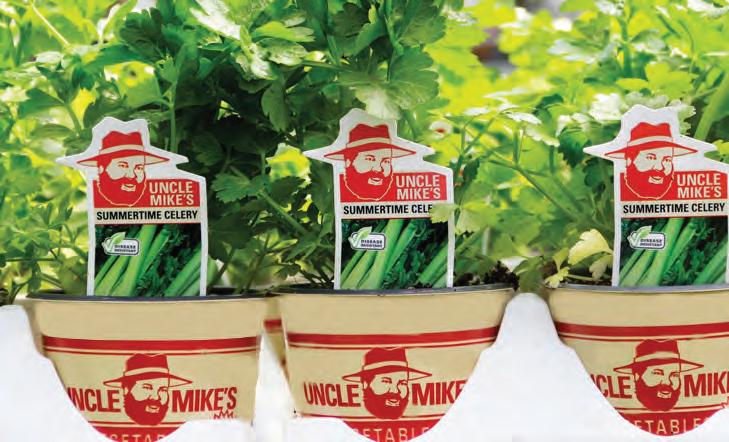
2 edible VINEYARD
DESIGN
PROOFREADER Barbara
AD SALES
Sharisse
•
PUBLISHERS Peter and Barbara Oberfest EDITORS Tina Miller and Connie Berry tina@mvtimes.com • connie@mvtimes.com CREATIVE DIRECTOR Kristófer Rabasca PRODUCTION/DESIGN MANAGER Dave Plath
Nicole Jackson
Dudley Davis
Jenna Lambert • jenna@mvtimes.com
Scott-Rawlins
sharisse@mvtimes.com
Feel good about the food you grow. On Martha’s Vineyard Uncle MIke’s herbs & veggies are sold exclusively at Jardin Mahoney. 45 Edgartown Vineyard Haven Road Oak Bluffs - 508.693.3511 www.jardinmahoneymv.com Follow us @JardinMahoney With UNCLE MIKE’S Herbs & Veggies you get quality, non-GMO plants that are selected for their ability to perform in our New England climate and are grown with Integrated Pest Managment (the good bugs eat the bad bugs) so you can feel good about growing organically at home.
Wages are 27% below the state median, rents are 30% above and 1 in 3 Islanders are 65+, many on fixed incomes. It all adds up to food insecurity. We’re on a mission to end it.






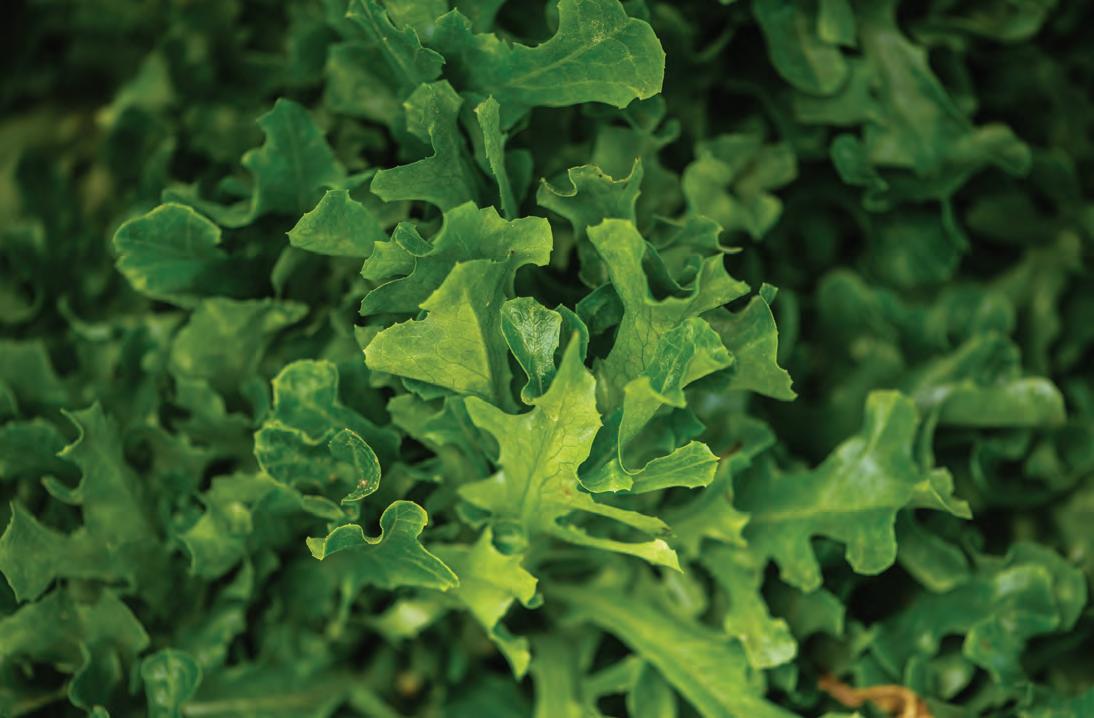
offerings, glean harvested fields,
deliver
The facts are clear. Even on Martha’s Vineyard, hunger is real. SBS THE GRAIN STORE Blue Seal & Organic feed & seed Hay • Shavings • Straw 480 State Road, Tisbury 50 8- 696 7271 Come experience the bounty We are now open year round Growing together with you, our community Davis House Gallery Open by appointment 985 State Road, West Tisbury allenwhiting.com · 508.693.4691
We stock the Island Food Pantry with nutritious
grow fresh produce, provide lunches for kids, prepare and
meals to the homebound. Please donate today. Learn more at igimv.org.

After relaunching Edible Vineyard in 2019, this is the first year we are adding a fourth issue, Off Season. This is a cov eted time of year on the Island because it gives us a chance to rest and to reboot. To look ahead and map out the next season. To hunker down and cook comforting meals. To go to or host potlucks. Our first Off Season issue is packed with recipes.



Catherine Young, writer, cook, and collaborator on Chris Fisher’s James Beard award-winning “The Beetlebung Farm Cookbook,” interviews Claudia Fleming about her gorgeous new cookbook, “Delectable: Sweet & Savory Baking,” just published by Random House. We feel grateful to share this interview and a few yummy recipes. Also in this issue, we join our own Mollie Doyle who loves cooking with her daughter Emma. She shares some of her vegetarian favorites to cook at home any night of the week.

Geoff Currier meets up with Island favorite musician, fisherman, and mason, Johnny Hoy.
Lucas Thors dives deep into the off-season when Island hunters rejoice and head into the woods and fields with a passion for venison and harvesting locally. Not only is hunting rewarding, but it allows them to fill their freezers for the winter. The hunters are also helping to keep down the Island’s deer population, since they really face no predators except automobiles.
Gina Solon returns to Edible, featuring some recipes cooked on the Whiting Farm with her husband Davis Solon and his aunt and uncle, Allen and Lynne Whiting.


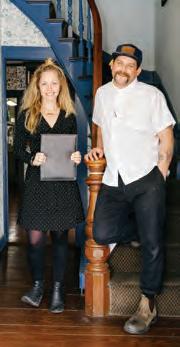

This all sounds like a lot for Off Season, but if you think about the opposite season, the summer season on the Island, this feels pretty relaxed. So pull up to the fire, cook some beautiful meals, and enjoy these moments with friends and family. And don’t forget to breathe that cool, crisp air.

EDITORS’ LETTER FARMSTAND HOURS: 8 AM -5 PM Closed Tue & Wed CHEESE • BEEF • PORK • LAMB • EGGS VEGETABLES • RAW MILK • BREAD • PASTRY Check out our website for winter activities THEGREYBARNANDFARM.COM
MILLER 63 CIRCUT AVE. OAK BLUFFS, MA (508) 696-0200 | sweetlifemv.com OPEN YEAR ROUND off season 2022 5
JOHNNY
DISHING
7 V ineyard Finds Picks to turn up the heat for you.
By Gwyn McAllister DRINKS 2 2 Liquid c ourage Ethically made and delicious wines.
By Sam Decker
FEATURES 10 S weet and savory In the kitchen with cookbook author Claudia Fleming.
By Catherine Young 15 S teak out Venison secures a succulent spot in the Vineyard diet.
By Lucas Thors 18 The buzz on bees Island beekeepers show us the honey.
By Amelia Smith 2 9 Keep it simple Vegetarian cooking can be quick and hearty.
By Mollie Doyle
FARM AND SEA
2 4 Johnn y Hoy and the codfish Frontman and fisherman talks fishing then and now. By Geoff Currier
ON THE FARM
35 Dinner at the D avis House Sharing a meal in a house with history. By Tina Miller
42 D ark and stormy nights The off-season gets even more quiet in a storm. By Kate Athearn


IN SEASON 44 C ome and get it! Succotash chowder brings everyone to the table on a chilly night. By Tina Miller
DONE!
48 F or the birds An Island expert weighs in on avian comings and goings. By Susan Whiting
COVER IMAGE: Ginger-Stout Layer Cake with Ermine Frosting from Claudia Fleming’s cookbook “Delectable: Sweet & Savory Baking.” –Johnny Miller
CONTENTS MV TIMES
Bombay Indian Cuisine
After years of waiting — and much wishful thinking among Islanders — the Vineyard has now added Indian cuisine to its range of ethnic offerings. This past October, Austin Grande and partner Sydney Scannell opened Bombay Indian Cuisine on Dukes County Avenue in Oak Bluffs. Currently Bombay is only open for takeout, but the 79seat restaurant also offers a dine-in table option. (Staff shortages have delayed waiter service for the time being.)
What a trip to the restaurant may lack in the full-scale dining experience, the food will more than make up for. Everything is made on premises from scratch, including
WORDS Gwyn McAllister
all the sauces, sides, and even the roti and naan (traditional Indian breads). Grande uses all organic ingredients and imports his spices and flours from India.
The Bombay Indian menu includes staples like Tikka Masala, Vindaloo, Kor ma, and curries, but there are also a cou ple of surprises. Grande is experimenting with fusion dishes that incorporate Indian touches with items associated with other cuisines. His street corn features masala, lime, and cilantro, as opposed to the Mexican version with mayonnaise and cotija cheese, and Lemon Ginger Lobster Rangoons are on the menu.
Grande is joined in the kitchen by his longtime friend and colleague, Mark
Left: Saag Paneer, paneer cheese cooked with a spinach-based curry.

Bottom right: Butter Chicken, chicken stewed in a homemade butter sauce.
Thompson, who aside from working in numerous successful restaurants has also spent time cooking for the New England Patriots.
Friends had suggested to Grande that he purchase his masala (a blend of Indian spices used in a lot of traditional cuisine) and other premade ingredients from restaurant suppliers. “That’s just an insult to the craft,” says Grande, a purist when it comes to cooking. He also insists on using only fresh produce, and makes every effort to purchase local ingredients.
“You can use frozen spinach, but why would you?” he says. “I’m hoping we can change the dy namic of Indian
off season 2022 7 VINEYARD FINDS
Continued on page 8
FINDS
Turn up the heat in more ways than one this winter, with some locally made and products guaranteed to take the chill off.
COURTESY BOMBAY INDIAN
food in the U.S. with fresh ingredients.”
Grande explains that there really are no shortcuts to cooking authentic Indian. “It’s a challenge. It’s not like any other cuisine,” he says. “You’re using 20 differ ent spices in one dish, and all are being incorporated at different times along the way. It’s really an art form. It has to be done slowly.”
Doing things the right way also requires a combination of artistry and science. “For the naan, you have to have the right climate to get the bubbles to form,” says Grande, who has done a good deal of experimenting to perfect that dish. “I’ve found that if the kitchen door is open, you get bubbles. If it’s closed, you don’t.”
Although some chefs bake tandoori dishes in a conventional oven, Grande refuses to compromise, and so he won’t be offering that marinated specialty until he can (hopefully in the near future) purchase a traditional tandoori oven.
That perfectionist approach comes from a longtime immersion in Indian food and In dian culture. Grande was introduced to tra

ditional cooking by his stepmother, who hails from Western India. She would often cook for the family when he was growing up. Lat er the aspiring chef moved to India, where he eventually worked in a Michelin-starred restaurant in New Delhi. Upon returning to the States, Grande went on to work in a number of different upscale restaurants in Boston and other New England locations, including a stint as head chef for Intermis sion Tavern on Tremont Street. However, he was never able to pursue his love of Indian cooking until last year, when he and his girlfriend opened a takeout-only spot at the business park at the airport.
The venture proved so successful that the couple decided to take the leap and open a full-service restaurant. Grande still travels to India when he can. He has visited spice farms there, and arranged for his own connections to local suppliers.

Grande’s love for all things Indian extends beyond his culinary ventures. “I was brought to tears when I first saw the Taj Mahal,” he says. “It’s such a marvel of engineering and art.” Perhaps the same could be said for the Bombay Indian menu.
Bombay Indian Cuisine, 7 Oakland Ave., Oak Bluffs. Visit bombay-indian-cuisine. square.site/.
Mimi’s Hittin’ the Sauce
Cathy and Mark Peters of West Tisbury have been bottling and selling their own hot sauce since 2016. Mark grows the sev en varieties of peppers in their gardens, and Cathy cooks up the sauce according to well-guarded recipes. All in all, the Pe ters’ sauces, which go by the brandname Mimi’s Hittin’ the Sauce, have taken home numerous top awards internation ally. Now the couple has added a spice mix that combines their homegrown peppers with maple sugar from Vermont and a variety of other dried ingredients, that can jazz up just about anything from meats and veggies to dips and popcorn (one of Cathy’s favorite uses).
Mark starts his pepper seedlings indoors in the dead of winter, then transfers them to a heated greenhouse until they’re ready to go in the ground in early summer. Harvesting occurs in the fall, and the next few months are devoted to drying the ripe peppers in two dehydrators in the Peters’ home, then vacuum-packing them. Cathy uses an Island commercial kitchen to cook up and bottle her concoctions. All in all, the Peters grow and harvest seven different varieties, from the familiar — habaneros, ghost peppers, and Scotch
8 edible VINEYARD VINEYARD
FINDS
Continued
page 7
from
Mimi’s rubs are great on everything.
LEFT, COURTESY BOMBAY INDIAN. ABOVE, COURTESY MIMI’S HITTIN’ THE SAUCE
Sweet Rice Pudding with rose water and pistachios.
bonnets — to a few with very colorful names: Scorpion, Carolina Reaper, Dragon’s Breath, and Komodo Dragon.
Cathy’s recipes all feature similarly inventive names like “Gonna Git Ya” (hot), “Smack My Ass” (extra hot), and “My Body’s on Fire, Strip Off My Attire” (extra-extra hot). The spice mixes and rubs go by somewhat less provocative but equally creative descriptives — “Don’t Rub Me Wrong” (mild), and “Get Your Rub On” (spicy).
Cathy had to keep experimenting until she arrived at a sauce that was fiery enough to win second place in the pres tigious Old Boney Mountain hot sauce competition in California. The 500 or so yearly contestants hail from nine different countries, but Mimi’s Hittin’ the Sauce has managed to proudly represent the Vine yard — taking home half a dozen first or second prizes in various categories (mild, medium, and hot) over the years.

Next up, the Peters plan to start offer ing a taco and chili seasoning mix in two temperature levels. The recipe will fea ture, among other things, a spice blend, garlic, brown sugar, and — surprisingly — cocoa and coffee powder.
Cathy believes in adding a bit of heat to just about everything (although she herself
can only manage the mild varieties). “I want people to think outside the box,” she says, adding that she and her husband add the sauces and spice mixes to egg dishes, chow der, and more, and use it as dipping sauce. She also recommends making your own barbecue chips by sprinkling some of the spice mix into a bag and shaking vigorously. One customer even swears by the hottest of the hot — taken straight out of the bottle — as the ultimate hangover cure.
Visit them on Facebook at bit.ly/MimisFB.
Island Alpaca
Stay warm and cozy this winter with a hand-knit item from Island Alpaca. Owner Barbara Ronchetti offers hats, scarves, gloves, mittens, baby jackets, and onesies that are as local as it gets. Her own flock collaborates with a core of Island knitters to provide the softest, warmest natural-fiber attire you can find anywhere.
Ronchetti explains the difference between wool (the fleece of sheep, goats, and rabbits) and alpaca fiber: “Because alpaca fiber is hollow-cored, it acts as an
effective insulator, and is known to be 30 percent warmer than most breeds of sheep. It helps keep you warm in winter and cool in summer. It also naturally wicks and draws moisture away from the body, and allows it to evaporate quickly, so you stay dry and comfortable.” According to Ronchetti, alpaca fiber is also hypoallergenic.
Along with the locally sourced and Vineyard-made products, the Island Alpaca gift shop also offers hundreds of other alpaca options, including blankets, sweaters, shawls, and ponchos, bags, baskets, and even stuffed animals — all made in the U.S. from smallfarm fiber or from a fiber cooperative to which Ronchetti contributes material from her own flock for a fiber blend.

Whether or not you’re looking for a gift item, a visit to Island Alpaca’s herd can provide a great outing for every member of the family. Ronchetti and her staff are always on hand during farm hours, and are happy to share their knowledge with visitors. And who could possibly feel the winter blues while petting a fuzzy-topped head?
Island Alpaca, 1 Head of the Pond Road, wVineyard Haven. Visit islandalpaca.com
COURTESY ISLAND ALPACA
off season 2022 9 VINEYARD FINDS
Beautiful baby sweaters made from alpaca wool.
Award-winning Mimi’s Hittin’ the Sauce.

10 edible
VINEYARD
WORDS Catherine Young IMAGES Johnny Miller
FEATURE Sweet and Savory
Claudia Fleming, author of the cook book "Delectable," in the kitchen.
A conversation about books and baking with Claudia Fleming.
Claudia last visited the Island in 2021. She caught the ferry in Orient, a few miles from her home on the North Fork of Long Island. It lands in New London, making the trip easy, especial ly so in April when there is not much traffic on the Cape.
Claudia brought pizzelles — not the sweet version, but a savory twist on the Italian clas sic. Eager for tasters, we drove up to Aquinnah to check in with a Dutch friend whose expertise we valued because of his coun try’s fondness for waffle cook ies (in this case, flavored with cheese from his homeland). I loved Claudia’s creation, but we wanted confirmation. When the Gouda Pizzelles were a hit, we both exhaled and head ed down-Island to continue baking.
Claudia and I go back — we cooked together at Tribeca Grill in 1990. I was new to restaurants, but Claudia was already a veteran. She cut her teeth working front-of-house at Jams, then Union Square Café. By the time our paths crossed, she’d shifted focus and taken up pastry with what I would learn was characteristic intensity. At Tribeca she assisted Gerry Hayden, the talented young sous-chef who ran the restaurant’s dessert department.
After two years she wanted to stretch herself, and left New York for France to stage at Fauchon in Paris and a pastry shop in Biarritz; we stayed in touch. Then in 1994 we worked together again. Claudia had honed her skills, and Tom Colicchio hired her as the opening pastry chef of Danny Meyer’s new venture. There, at Gramercy Tavern, Claudia developed a roster of desserts that led the James Beard Foundation to name her Outstanding Pastry Chef of 2000. The following year she pub lished “The Last Course,” a cook book that became a classic because it enabled others to replicate Clau dia’s sophisticated sweets.
Claudia reconnected with her onetime boss, Gerry, at the 2000 Beard awards. They married, and then left the city to open the North Fork Table and Inn in Southold, Long Island. At the end of 2019, she said goodbye to the restaurant after 13 years. She wanted to take a step
back. “Delectable: Sweet & Savory Baking” (Penguin Random House, 2022), a cook book we wrote together, is the outcome. Claudia and I recently sat down for a chat.


People cherish your book, “The Last Course.”
Why did it take so long to do another?
I was busy. Gerry and I opened the North Fork Table and Inn in 2006. We didn’t have tons of money, so we had to do everything ourselves. I was the pastry chef, and also responsible for breakfast baking. When Gerry was diagnosed with ALS in 2011, he stayed as involved as he could, but my responsibilities broadened. Gerry lost his battle in 2015, and, even though I had help from our partners and friends, I felt like it all fell on me. After five more years, it was time to sell the restaurant — I couldn’t do it anymore. I needed time.
You used the time to write a book. What should readers expect?
From my point of view, this book is en tirely different from the other. It’s a col lection of recipes I bake at home. I cooked everything on my electric stove. My goal with “The Last Course” was to make the multifaceted desserts we served at Gramercy accessible beyond a profes sional kitchen. In “Delectable,” the reci pes are my baking projects — done over a year when like most, I stayed home. Some recipes are variations on things I served at the North Fork Table or Gramercy, others favorites I grew up eating, and the rest simply what I wanted or thought my friends would like.
Cooking at home is quite a change from running a restaurant.
Yes, it was. But it was what I needed. It allowed me to go slowly with each recipe, and get it where I wanted it without the pressure you have in a restaurant. I cooked for myself, con scious that I wanted to make recipes that would work for someone with out restaurant training. The Apple Tartlets in the book, for example, are delicious, but have only three compo nents: an easy cream cheese dough, apple butter (time-consuming, but a cinch), and sliced apple. You can even simplify further, and use commercial puff pastry for the crust — just roll, layer, and bake.
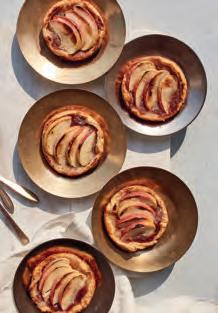
Was it difficult to develop recipes alone? Honestly, it was bucolic. My kitchen is puny, but I can see the water from my little porch. I like to cook with local pro duce, and there are wonderful farms within a few miles. Like Martha’s Vineyard, the population ebbs after the summer vacation season, the days pass slowly, and that feels like a luxury. For pantry items, I shopped at the local grocery, which is pretty well-stocked, but doesn’t carry specialty items. Fine by me. The biggest challenges were pandemic shortages of flour and yeast. I wound up trading with a friend who kept her juice bar open.
Are you still cooking at home these days?
Not as much as I’d like. After a year I needed a job, and when restaurants began to reopen, I reached out to Danny Meyer. I’d worked for Danny at the beginning of my career, then
off season 2022 11
Sweet and Savory FEATURE
Apple Tartlets
Chocolate Mousse
at Gramercy. He has always been very supportive, and offered me a position as culinary director for Daily Provisions. I am responsible for menu development and execution. It’s a big job, but I like it, though it does limit my time on the North Fork.
You’ve included recipes for dishes you grew up eating. Tell me about your family. My father was Irish, but my mother’s par ents came from Sicily. She was an excellent cook, and made the food in our house. We ate chicory — never iceberg let tuce. Although I coveted “American” food, we lived in Brentwood [Long Island], and there were lots of other Italian families. I could go to the Sta sis’ house the day after Christmas and know I’d find wonderful escarole pie. Thinking about my family, I remem ber my grandmother’s pasta con le sarde — a deeply savory, but slight ly sweet, combination of sardines, fennel, pine nuts, and raisins I loved. We would visit her in the Bronx, and my mother would shop at the Italian markets before or afterward. I was happy to go with. I looked forward to the freshly baked taralli and pignoli cookies they sold.
Did your mother bake?
She baked a few things very well. For company she’d make either apple turnovers or chocolate cream pie for dessert — both really good. During the holidays she baked cookies. I can still taste her butter cookies. We also always had pizzelles. My grand mother would make hundreds, one at a time, with her stovetop iron. My aunt liked to flavor them with orange zest and liqueur. They were yummy, but I preferred plain sugar, or those flavored with fennel or anise seed.

Is the Ginger-Stout Cake in your book a family recipe?

No. I got that when I worked at Bright Food Shop, a Mexican fusion din er that used to be in Chelsea. Dona
Abraham and Stuart Tarabour, the owners, were good, thoughtful cooks. Dona gave me the recipe, which started out as a ginger bread. It’s not too sweet, moist, and very flavorful. We served slices. Since then I’ve accompanied it every which way — a good cake is a treasure. The idea to frost it first came when I had to make a birthday cake for a friend who loves Guinness. For the book, I decided to go with Ermine Frosting, an adaptation of a recipe my friend and for
mer partner Mary Maraz introduced me to. She makes the Southern roux-based spe cialty the traditional way, with whole milk. I wanted tang, so substituted buttermilk.
Any secrets to making a great cake?
Generally speaking, I’d say for all success ful bakes, you need a scale and an oven thermometer. For cakes, I’d add to that list of essentials taking the time to let your ingredients come to room temperature. A batter requires blending ingredients; if everything, including the eggs, is the same temperature, you get better emulsification, and that leads to a ten der, moist cake.
Talking about holiday baking, what’s your favorite way to celebrate New Year’s Eve?
I spend Christmas with my family, but New Year’s I like to have cham pagne with close friends.
Will you cook this year?
Who knows? My life is a little unpre dictable these days, but if I do, I think something decadent like Chocolate Mousse would be in order, and you can make it ahead. Wait, actually, what I’d really like is Gruyere and Onion Cocktail Biscuits. I was playing with recipes for the book and decided to mix anchovies and onions, and add them to little biscuits. They turned out great — I like them better than gougères. They’d be perfect.
Any guidance for making them well? Keep your ingredients cold, and freeze the butter, whenever you make bis cuits. The goal is lamination — coating small butter morsels with flour — rath er than emulsification. I also cut and stack my dough before the final rollout to create layers. I work quickly and handle the dough as little as possi ble, because you don’t want the butter to melt or to activate the gluten in the flour. Beyond that, I’d say don’t skimp on the anchovies!
12 edible VINEYARD
FEATURE Sweet and Savory
“ From my point of view, this book is entirely different from the other. It’s a collection of recipes I bake at home. I cooked everything on my electric stove.” – CLAUDIA FLEMING
Pizzelle iron for creating Italian waffle cookies.
Europeaninspired savory pizzelles.
BLACKBERRY SHORTCAKE

MAKES 9 SHORTCAKES
This dough contains hard-boiled egg yolks — an old trick for making a rich and tender biscuit. (See the note below for my preferred egg-cooking method.) Although I don’t gen erally reroll biscuit dough, I make an ex ception here so that I wind up with an extra cake, which I often as not keep for myself. By the way, this sweet dough is great not only for shortcake; it is also wonderful for cobblers.
SHORTCAKE BISCUITS:
340g all-purpose flour (12oz, about 2 ¼ cups + 3 Tbsp.) 55g sugar (2 oz, about ¼ cup)
2 T baking powder
0.7g Diamond Crystal kosher salt (¼ tsp.)
2 hard-boiled egg yolks * 114g unsalted butter (4 oz), chopped into ½-inch dice and frozen About 1 cup + 1 Tbsp. heavy cream
12g crystallized sugar, such as turbinado, Demerara, or Sugar In The Raw (0.4 oz, about 2 ½ tsp.)
BLACKBERRY REDUCTION:
340g fresh or frozen blackberries (12 oz, about 2 ½ cups)
70g sugar (2.5oz)
2 tsp. orange zest
YOGURT CREAM:
1 cup heavy cream
1 tsp. vanilla paste or pure vanilla extract
2 Tbsp. confectioners’ sugar
1 cup Greek-style yogurt (or yogurt drained overnight)
420g fresh blackberries (15 oz, about 3 cups)
Confectioners’ sugar, for dusting
*To hard-boil eggs, put them in a single layer in a small saucepan with water to cover by about 1 inch. Heat over medium heat until the water starts to steam, then increase the heat
off season 2022 13
Continued on page 46
Sweet and Savory FEATURE
Blackberry Shortcake

® certi edhumane.org
Steak out
Venison secures a succulent spot in the Vineyard diet.
Biologists estimate that the deer population on Martha’s Vineyard has recently grown as high as 50 deer per square mile, with the whole Island estimated at around 100 square miles in total — that’s a whole lot of meat.
Not only is venison healthy and delicious, but eating venison harvested from deer on Martha’s Vineyard puts the consumer just about as close to the source as possible. Brian Athearn, avid hunter and president of the Martha’s Vineyard Agricultural Society, told Edible Vineyard he got into hunting when he was young and just returning from the military. He started out with black powder hunting, but soon found his passion in shotgun hunting,

off season 2022 15 Steak out FEATURE
WORDS Lucas Thors IMAGES Brian Athearn
Venison roasts are tied up with butchers’ twine to preserve their form.
1
1. Deer legs ready to be roasted or smoked.
2. Brian Welch busy processing a recently killed deer.
3. Fresh venison makes for some delicious meatballs.
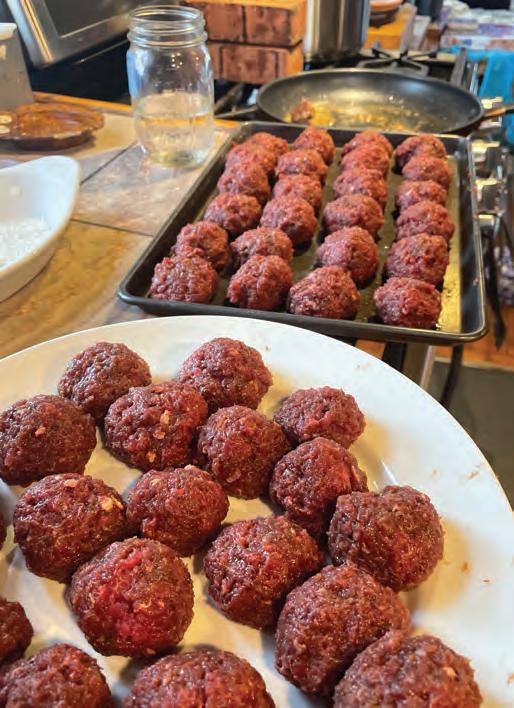
4. This venison is ready to be cut up and distributed to hungry Islanders.
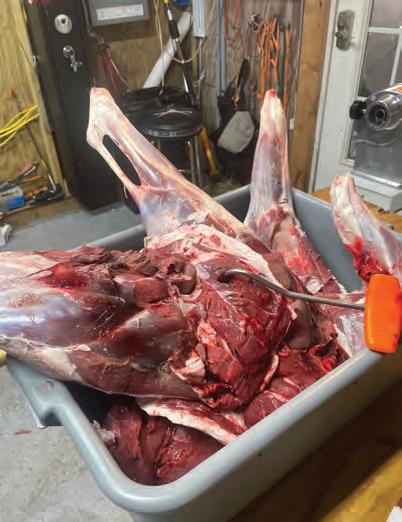


5. Cuts of dark red venison.
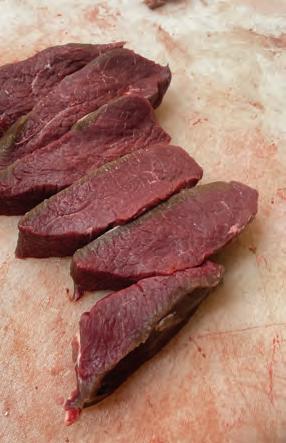
6. Venison is stored in vacuum bags to ensure a long freezer life.

16 edible VINEYARD FEATURE Steak out
45 6
2 3
and bowhunting eventually became his favorite way to take deer.
“Next thing you know, I’m looking around for a place to hang our deer,” Athearn said. “Chris Pantalone from down at Rocco’s [Pizzeria] was selling a walk-in cooler.” After a bit of back-and-forth, Athearn got a great deal on the cooler, and began setting it up down at his farm. Having a large enough storage space for the meat, Athearn said, is key to being able to age and preserve the tasty and protein-packed venison.
“When you have a walk-in cooler, you all of a sudden have a lot of friends,” Athearn laughed. “We all started getting together to hang and butcher deer, and that’s how the [M.V.] Hunt Club formed.” Athearn’s hunt club encourages new hunters, and provides them with a vast pool of decades of combined experience, along with knowledge on how to properly skin, quarter, and butcher a deer.
“Pulling the trigger on a deer is the easiest part, by far. From soup to nuts, it’s a whole lot of work to even get a deer. Finally you kill one, and now you have to deal with the deer, and process the meat the right way,” Athearn said. He soon learned unique and efficient techniques for process ing whole deer, and then started get ting into the various ways to prepare delicious meals out of venison.
For Athearn, venison is a staple of his family’s diet, and he said there are many different ways to serve the rich, dark red meat. At the M.V. Hunt Club, members work on preserving, aging, and cooking venison via a variety of methods. “I eat venison probably five times a week or more,” Athearn said.
According to Athearn, it takes hours to butcher a deer properly. With some finessing and experience, skinning and quartering a deer takes about 15 or 20 minutes. Skinning helps cool down the meat so it doesn’t spoil, and quartering involves separating the forequarters, hind quarters, and backstraps from the carcass. Having the right equipment helps, Athearn said, but even with the most efficient and refined techniques, getting venison ready for aging or storage is highly involved.
Apart from getting the deer processed, the aging process is also essential in producing a steak that is not only delicious,
but has a pleasant and buttery consistency. The Hunt Club folks like to age their deer for at least two or three weeks in a climate-controlled environment. Some times they age deer up to five weeks, which creates a tender consistency and allows the enzymes in the muscle to break down and eliminate that gamy taste that some report when eating venison.
“When people say deer meat is gamy, it’s because you butchered the deer and ate
water,” he said. Because venison is such a lean meat, especially when cooking a venison steak, you want to score the meat so that the heat can get inside the cut when using a pan or grill. “That way, it can cook faster on the inside, so you don’t end up with an overdone outside and an underdone inside,” Athearn explained.
Athearn often cubes his venison steaks so they cook more evenly, with more surface area exposed to the heat. This essentially achieves a similar goal to scoring five or six thick lines on either side of the steak. “You aren’t cubing it at that point, but allowing all the heat to really get in there,” he said.
For a succulent and flavorful meal, Athearn suggested scoring the steak, dredging in egg wash, and rolling in panko breadcrumbs. For those who like their steaks simple, a hot pan sear with a half-and-half mix of butter and olive oil is a great option. For the final touch, Athearn makes a beach plum reduction and drizzles it over the top of the steak. “That really brings out the natural flavor of the venison,” he said.
Of course, cooking up a tender steak isn’t the only way to enjoy venison. Grinding the venison into burger is also very popular on-Is land, and at that point, the only limit to what meal you whip up is your creativity and how hungry you are.
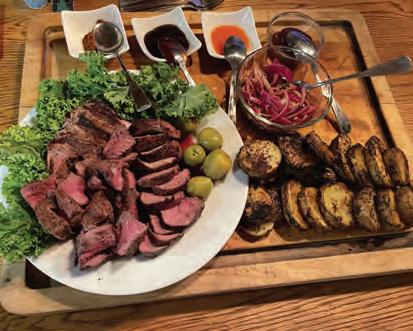
“Chili and burgers are definitely de facto. We will do Taco Tuesdays, and you really can’t beat a venison taco,” Athearn said. He also recommends sloppy joes and venison stir-fries as solid options for preparation. “When you shoot a smaller deer, we’ve even done a whole one of those on the smoker,” he said.
it the very next day,” Athearn said. “If you butchered a cow and ate it the very next day, it would be gamy too.” He stressed the importance of aging deer, and related it to aging cask-strength whiskey. “You lose a lot of weight from evaporation, but what you get out at the end is so much better. Actually, it’s amazing,” Athearn said.
As far as cooking venison, Athearn said the key is to make sure all the meat cooks evenly. “You really don’t want to overcook venison. Everyone is always skeptical about undercooked meat, but if you cook it too much, you are dead in the
One special way venison is becoming more prominent in the mainstream diet of Islanders is through the venison donation program, managed by Island Grown Initiative and the Ag Society. The donation program allows hunters to donate their kills so the meat is processed properly. Then all that fresh meat is sent out to organizations like the Island Food Pantry and the Wampanoag Tribe of Gay Head, to support the local elderly population, along with anyone who is hungry or in need. “It’s pretty amazing, having a legitimate way to put wild game meat back into the diet of our community,” Athearn said.
off season 2022 17 Steak out FEATURE
“When people say deer meat is gamy, it’s because you butchered the deer and ate it the very next day. If you butchered a cow and ate it the very next day, it would be gamy too.”
–BRIAN ATHEARN
Fresh venison with roasted potatoes and a garnish of greens.
We’ve got the buzz on bees
Island beekeepers talk hives, honey, and mites.

Winter is a quiet time of year for bees, but when spring comes, they’ll be buzzing in trees, flowers, and gardens all over the Island, thanks to a growing number of dedicated local beekeepers. Beehives can be found beside wide-open fields and on little half-acre lots,
and the bees’ health relies on a steady supply of nectar through the growing season, and careful tending by their beekeepers. Challenges include drought, like this past summer’s, which dries up the nectar of flowers, and the dreaded Varroa destructor mite. But if the bees do well, there’s honey in the end for the beekeeper, with well-pollinated gardens along the way.
Nina Gordon first thought about keeping bees after some local honey she bought
turned out to be not so local after all. “I thought, What do I have to do to get actual local honey, keep bees?” she says. Years lat er, when her younger child went to college, she finally had a little extra time to pursue a hobby. A friend of hers gave her their old equipment, which helped her get started; a smoker, bee suit, and hive. But when she tried to order bees, she found out that it was too late in the year — you need to order bees in February or March. Nina spent the next
18 edible VINEYARD
WORDS Amelia Smith IMAGES Tina Miller
FEATURE We’ve got the buzz on bees
year reading and studying, learning a lot before she brought her first bees home.
Now she keeps a couple of hives in her yard, and helps a few other people with their hives too. She looks into the hives once a week during the warm part of the year, checking them for signs of trouble, to see how the bees’ honey supply is doing, and to take out any bees that aren’t doing well. “I don’t think of bees as individuals,” she says. “The colony is the organism,
and it reproduces by swarming. They don’t mind sacrificing themselves to save the queen and the colony.” Nina wears a jacket and hood to protect her face, but no gloves. Gloves make it a little harder for her to work smoothly, and being clumsy around the hive can agitate the bees, which is the opposite of what she wants. She looks over the cells to see the pattern in the brood the queen has laid, and whether it’s developing as it should. In the spring, she checks to see if the hive is getting ready to split and swarm, which she tries to avoid. “Swarming bees may make hives in inconvenient places, like neighbors’ houses,” Nina says.
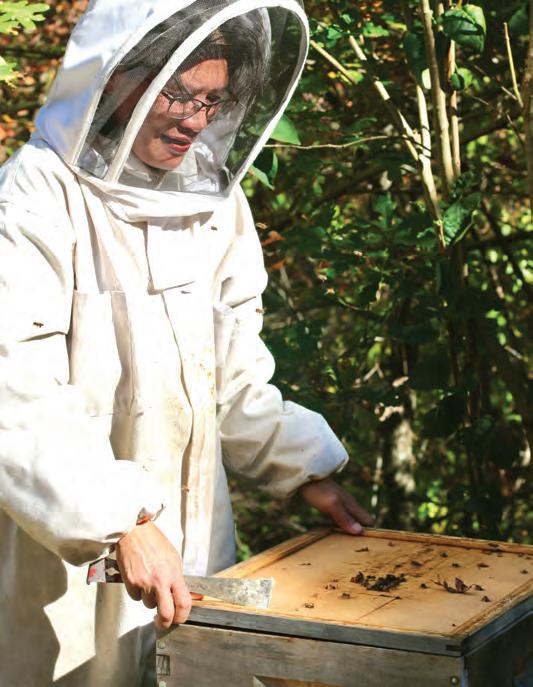
Sometimes wild bees make hives on the Island, too. Juli Vanderhoop has been keep ing bees in Aquinnah since someone gave her a few hives about 13 or 14 years ago. She adopted some wild bees this year — a swarm had set up its hive inside the wall of a neighbor’s house. They had to cut the wall to get the colony of bees out and into a hive box, and Juli is now looking forward to seeing how they’ll do through the winter.
“I’ve just gotten further and further into the study of bees,” Juli says. “I’m constant ly wondering about what my bees are into.” One spring, she had so many bees on her maple tree that it was vibrating. “That maple sugar in it was very attractive to the bees, and they were just all over it. It’s a rare type — it’s grown much larger than I had expected it to.”

Bees feed on differ ent flowering plants at different times of year, from flowering trees to blueberry bushes, and late in the summer, on goldenrod and knotweed. Nina says that some of the most delicious honey she’s tasted came from a hive near a cranberry bog. Goldenrod honey is dark and strong-fla vored, and it’s good for the bees to keep it to feed on in the winter.
While some beekeep ers get started through gifts from friends or a passing curiosity, for others it’s a family legacy. When Ben Cabot’s uncle, Andy Boass, passed away unexpectedly in 2015, Ben and his kids
–NINA GORDON
“
I don’t think of bees as individuals. The colony is the organism, and it reproduces by swarming. They don’t mind sacrificing themselves to save the queen and the colony.
”
FEATURE
We’ve
got the buzz on bees
Nina Gordon checking her hive.
took over Andy’s hives. Ben keeps a hive at his house in West Tisbury and one at his uncle’s old house, and also takes care of half a dozen hives at Beetlebung Farm in Chilmark. The drought and the heat this summer were hard on his hives in West Tisbury, but the ones at the farm thrived because the irrigation there gave blossoming plants plenty of moisture. The grove of beetlebung trees just next
to the hives helped, too. “Every hive is different, every year is different,” he says. He coordinates with several other local beekeepers to order bees, including Garrison Vieira, who is a sergeant in the West Tisbury Police Department, and vice president of the Martha’s Vineyard Agricultural Society. Garrison got started in beekeeping about 12 years ago. “My dad did it for a year or two, and my mom kept the stuff. I decided to try it,” he says. It was a way to reconnect with his father, who had died when Garrison was young. He laughs at the idea of selling the honey from his bees. “My wife and girls go through it like it’s going out of style,” he says, but occasionally he might give a jar of honey as a gift.
–JULI VANDERHOOP
Tim Colon of Island Bee Co. got started in beekeeping because one of the cabinetmakers he worked with had hives. He started doing it at home, and his kids would sell the honey on the street. In 1999, Tim and his wife Tricia took over a farmer’s market stand from beekeeper Neil Flynn. Now it’s a thriving family business that keeps him busy full-time for much of the year. Tim has about 80 hives around the Island, and is hoping to add more, but not too many. Even though he’s been keeping bees for decades, there’s always more to learn. He is currently one of 200 beekeepers in New England in a program run by Penn State University, to learn about queen rearing and artificial insemination of bees. The group meets online every other week for an hour, with guest speakers. Cooperation and continuing education are vital for all beekeep ers. Nina and Juli are part of a small bee club that they call the Buzz Buddies, about eight Island beekeepers who help one another and learn together. They’ll get together to open up hives and see what’s happening in there, whether the brood cells are going to be drones or workers, if the hive looks healthy, and if it needs to be treated for mites. “A lot of information is passed back and forth, and it’s
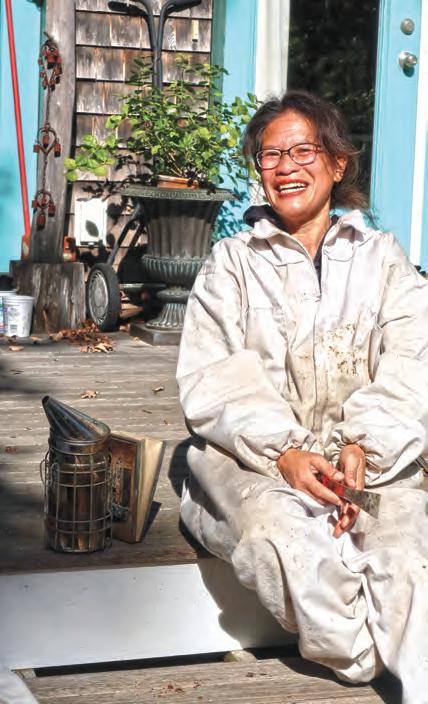
been great,” Juli says. They sometimes get together for honey tastings, and to physically help each other — a hive box that’s full of honey can weigh 40 to 50 pounds, so there’s some heavy lifting involved.
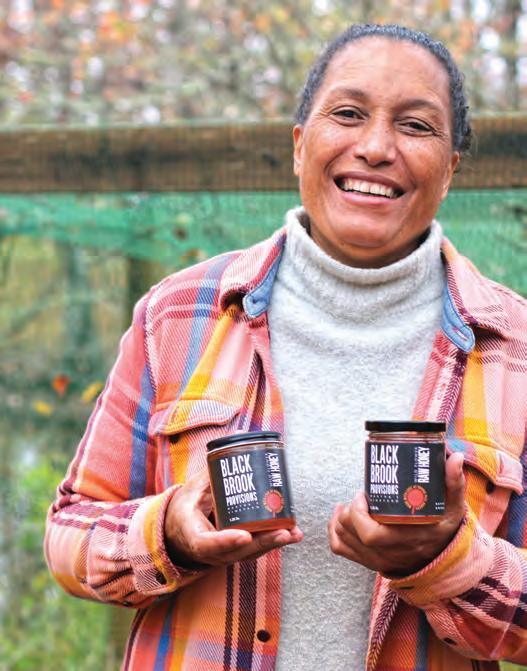
Ben Cabot joined a Plymouth-based beekeeping group, which he finds a great resource for knowledge and advice. When Garrison was a newer beekeeper, he had Kim Skyrm, the state apiary program coor dinator, come to inspect his hives and make

“
I’ve just gotten further and further into the study of bees. I’m constantly wondering about what my bees are into.”
Nina Gordon in her bee suit at home.
20 edible VINEYARD
Juli Vanderhoop with jars of her beautiful Aquinnah honey.
FEATURE We’ve got the buzz on bees
sure that he was on the right path, which he found very helpful. Recently he has helped to set up classes and hive inspections for Island beekeepers by the Massachusetts Department of Agriculture, through the M.V. Agricultural Society.
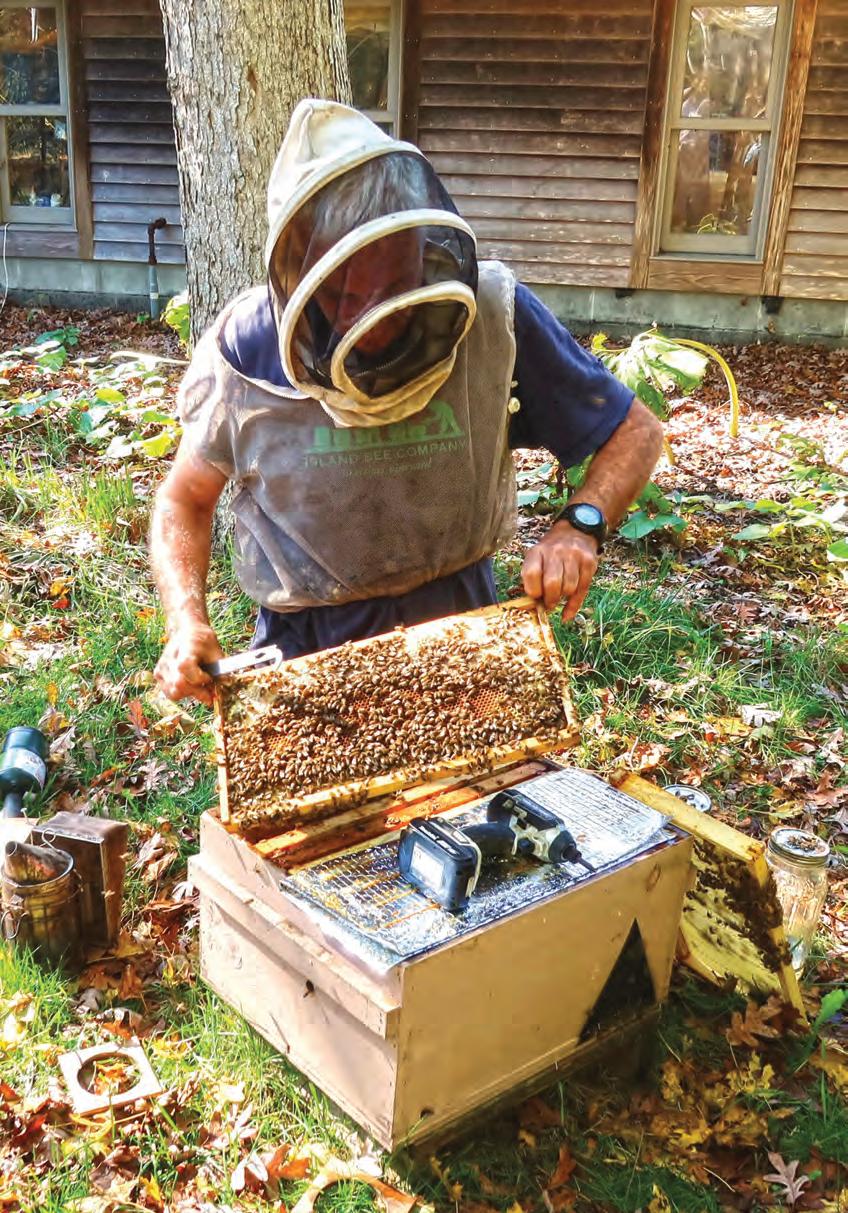
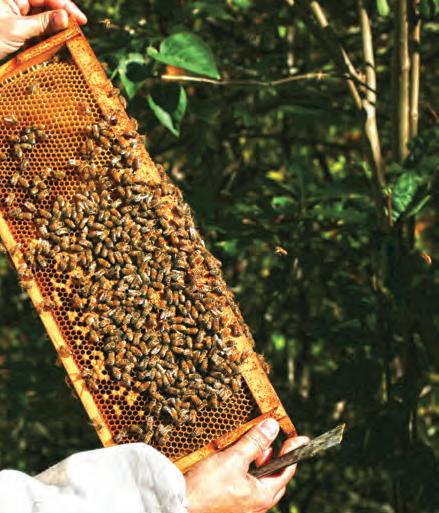
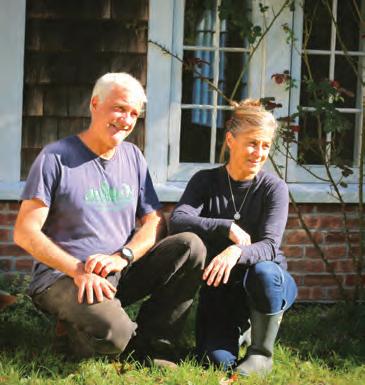
Every beekeeper I spoke with stressed the importance of responsible beekeeping. “They need help,” Juli says. “If someone has an untended hive, that will spread disease.” Tim is even more adamant about

responsible beekeeping: “People who don’t take care of their hives encourage the Var roa mite, which is a huge vector of disease, and spread the mite and its viruses to other bees,” he says. Nina likens the Varroa mite to ticks — not great in themselves, but most dangerous for the diseases they carry. An overpopulation of honeybees can threaten local pollinators, which can be a concern in highly populated areas.
Beekeeping isn’t for everyone — it
takes work, there’s the risk of occasional stings, and some hives don’t make it through a winter, struggle to find food during a dry summer, or fall prey to mites or other pests. Then again, there’s the cheerful buzz of bees in the yard, and honey, lighter-colored in the spring, darker in the fall, taking on the flavors of the plant world, from light clover to rich chestnut, a spectrum of tastes that reflects the landscape all around.
off season 2022 21
Nina Gordon doesn’t wear gloves when checking the hives.
This past season honey from Island Bee Company
Tim Colon and Tricia Sirakovsky at their home in Vineyard Haven.
FEATURE
We’ve got the buzz on bees
Tim Colon checking the hive.
Liquid courage
For example, his colleagues maintain that nighttime harvesting is a prereq uisite for producing quality wine (the rationale being that cooler temperatures preserve the freshness of the grapes). Steve and his crew do it differently, never starting before daylight.
“Why kill ourselves?” asked Steve. “There’s a lot more to making wine than the six-week sprint of harvest.”
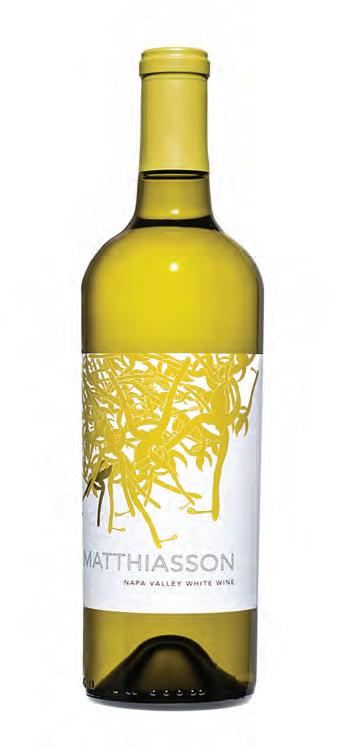
He went on to explain that the prac tice of harvesting at night was never intended for small producers. Rather, it was introduced by large industrial wineries hoping to avoid the hottest part of the day by starting in the middle of the night.
Yet, ultimately, Steve’s argument was an ethical one: wine quality shouldn’t come at a human cost. Think about it: for vineyard workers, the complications that arise from irregular harvest schedules can be incredibly disruptive, requiring last-min ute rearrangements around everything from transporta tion to childcare.
round staff requires flexibility and creative work-arounds — like their practice of rotating vineyard workers into winery roles. But the effort pays off, resulting in a culture of collaboration, deep engagement, and a shared sense of purpose.
Like many, I first learned about Mat thiasson Wines in the pages of Jon Bonné’s 2013 book “New California Wine,” which traced the rise of a stylistic movement that positioned restraint and elegance as wine’s higher calling.
The movement was a game changer: it lit a fire under a new generation of producers and made “cool-climate Pinot Noir” a thing people actually said. However, by making it all about ripeness and alcohol, the movement failed to broaden the conversation from a de bate about style to a deeper one about ethics.
WORDS Sam Decker IMAGES Elizabeth Cecil
The first thing you’ll notice when visit ing Steve and Jill Matthiasson in Napa is that their vines are trained several inch es higher than those of their neighbors.
“It’s so our harvest crew doesn’t have to bend down as far when they’re working,” Steve explained during a recent visit.
Though widely recognized for their decades of leadership on environmental issues, it’s the couple’s growing commitment to social sustainability that makes their work feel more relevant than ever — particularly now, as the industry looks for a sense of purpose that can’t be reduced to a numerical score.
Our conversation soon turned to the subject of harvest.
A former philosophy student with a healthy independent streak, Steve is largely immune to the groupthink ten dencies that drive most industry norms.
As I spent more time with Steve and Jill, I became increasingly aware of a finely calibrated moral compass at the heart of every decision they make. Rather than accept wine’s quality-at-allcosts paradigm that often places aesthet ic goals at odds with ethical ones, the Matthiassons are proving that social responsi bility and wine excellence can, and should, go hand in hand.
Perhaps most radical of all is their employment policy: Matthiasson Wines is staffed almost exclusively by full-time, year-round employees — unheard of in an industry highly dependent on a robust migrant workforce. Maintaining a year-
This is exactly the conversation we need to be having now — and Steve and Jill, along with a new wave of mission-driven producers they’ve helped to inspire, are the best equipped to guide us.
Because here’s the thing: making Steve Matthiasson the face of New California Wine was like putting Bob Dylan on the cover of Acoustic Guitar magazine — it didn’t really get to the heart of what he’s all about.
Not to say that Matthi asson wines aren’t worth celebrating on the basis of deliciousness alone: their first bottle I tasted, the Napa Valley White, shot me like an arrow through the heart with its shimmery flavors of lime-tinged ricotta and acacia blos soms. Their Cabernet Sauvignon is also extraordinary.
But more than the wines themselves, it’s the Matthiassons’ ability to trace each stylistic decision back to an underlying ethical framework that makes their work so resonant and meaningful for me today.
Sam Decker is a sommelier, writer and co-founder of Wine + Peace, a new marketplace for responsibly made wine.
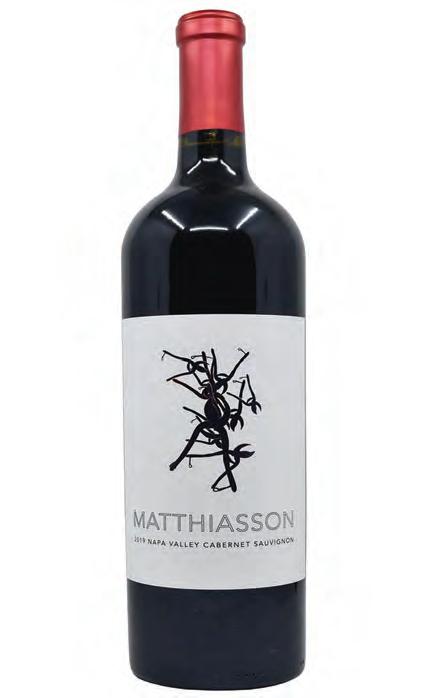
22 edible VINEYARD DRINKS Liquid courage
The Matthiassons’ quest to make wine more ethical and equitable.

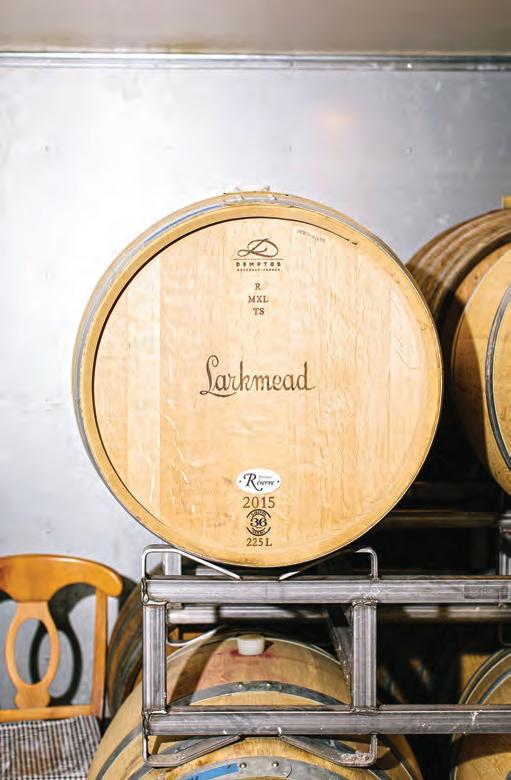

off season 2022 23 Liquid courage DRINKS
Steve and Jill Matthiasson, coowners of Matthiasson Wines, at their home in the Oak Knoll District of Napa Valley with the vineyard behind their house.
The Matthiassons’ vineyard in the Napa Valley. The family winery extends its ethical practices to every level of the process.
Most people on the Isla nd know Johnny Hoy as the frontman for the blues band Johnny Hoy and the Bluefish. What some may not realize is that Hoy is also a commercial fisherman, and when he’s not belting out Muddy Waters tunes, he’s hauling in codfish, tautog, and black sea bass. So we decided to check in with Johnny as the fishing season is winding down, and see what he plans on doing as we head into fall and winter.
In early October, we met up with Hoy and his childhood friend, Jim Tryon, who grew up with Hoy in Glastonberry, Conn., as they were dropping off their catch at Larsen’s Fish Market in Menemsha. It turned out to be a beautiful afternoon, although the water had been churned up considerably, as the remnants of Hurricane Ian had just come through. But Johnny knew enough not to get too comfortable with the weather. As we headed into November, the cold and blustery days would soon outnumber the balmy days of summer, and fishermen like Hoy, who continued fishing into the late fall and winter, knew what they were getting into.
Back in the ’80s, Hoy earned his money from gigging with his band and from doing some construction work and masonry jobs. It didn’t take him long to realize he’d rather be out on the water than sweating in a hot ditch or baking on a roof, and he made the switch to commercial fishing, although he still does the occasional masonry job to make ends meet. “Sometimes you just have to do what you’ve got to do,” he said.
Back in the old days, commercial fishermen were still making good money fishing for blues and striped bass, but these days, Johnny said, “The striped bass fishing is just not the same as it used to be, and these days it’s just not worth it economically,

so I find that I concentrate mostly on black sea bass, a delicious white-meat fish. I’m also a big fan of tautog,” Hoy said. Black sea bass have a season that stretches from June into December, and the tautog season is nearly as long.
Johnny’s 22-foot Hi-Liner pulled up to the dock at Larsen’s, and Hoy and Tryon unloaded two coolers of fish, mostly black sea bass, along with some tautog and a few codfish.
JOHNNY HOY AND THE CODFISH
He’s not only the frontman for a legendary Island band, he’s also a fisherman and an environmentalist.
WORDS Geoff Currier IMAGES Dena Porter
I mentioned to Hoy that last Thanksgiving, my daughter, her husband, and their two boys rented a house next to Split Rock on Lambert’s Cove Beach, and the boys were fishing and the waters were thick with black sea bass. Hoy told me the story of an old guy from Saugerties, N.Y., who used to come to the Vineyard and fish for weeks around Split Rock. Hoy would see him at the dock at the end of the day dragging a big, old metal Co ca-Cola cooler, looking beat-up, bloody, and exhausted, with all sorts of fish tales hanging out of the cooler. “All the young bucks were out fishing for game fish like blues and stripers,” Hoy said, “and this guy was catching black sea bass, tautog, black back flounder, and we thought, this guy knows shit about fishing that we don’t even know the half of. He was a big in fluence on my approach to fishing. The big lesson was to just keep fishing, and even in the off-season, there’s a lot of fish out there.
“Yes, it can get windy and blustery out there in the fall,” Hoy said, “but the fish are still out there. My birthday is on Jan. 10, and I try to get out there for that, and I’ve had some pretty good days, but the problem with fishing late in the season is not that all the fish just dry up, the problem is the lack of people to buy them.” Most people on the Island are summer people, and they head home when it gets cold, so there are not as many people to sell to.
24 edible VINEYARD
AND SEA
the
FARM
Johnny Hoy and
codfish
Johnny Hoy caught sea bass and cod on this fishing trip.
“All the young bucks were out fishing for game fish like blues and stripers, and this guy was catching black sea bass, tautog, blackback flounder, and we thought, this guy knows shit about fishing that we don’t even know the half of.” –Johnny Hoy

FARM AND SEA
off season 2022 25
Johnny’s catch included tautog, left, and codfish.
“Fortunately, we’ve got the M.V. Seafood Col laborative,” Hoy said. The collaborative started in 2021, and they ship some of the catch off-Island.
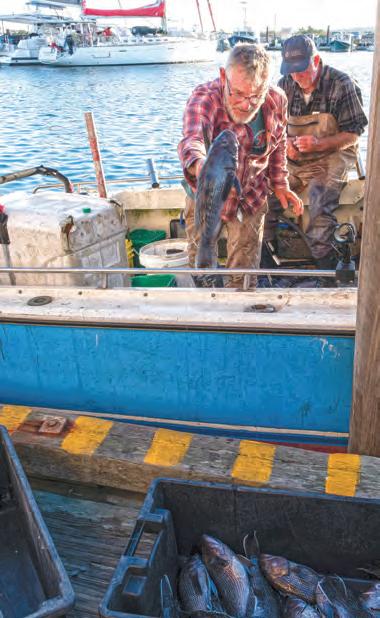
But as the dead of winter hits, and the fishing gets tougher, in addition to playing blues harp with the Bluefish, Hoy has a little boat he uses for oystering, which he can do all winter. He is on the West Tisbury shellfish commission, where he and the other commissioners work on finding the best ways to propagate oysters.


Hoy is also one of three people on the ri parian commission that decide when to open up the cut from Tisbury Great Pond, and James Pond, to the ocean. “One thing I’ve learned,” Hoy said, “is that everyone in town has their own theory on opening the cut, and that it’s far more complicated than most people know.”
The basic reason for opening the cut is to increase the salinity level in the pond, which helps shellfish grow, and famously allows female herring to spawn and baby herring in turn to go out to the open ocean. This is done several times throughout the year. “Originally it’s done with an excavator,” Hoy says, but he and a
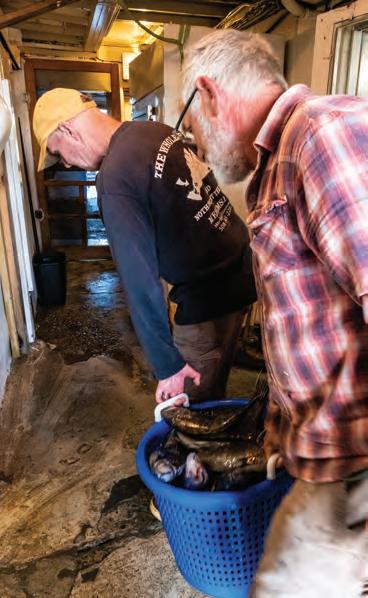
group of guys will also do the laborious job by hand when it starts to fill in.
But it’s not just her ring that seek the open ocean. Last July, Hoy saw a small river of baby flounder about an inch long, coming out of a hole behind the beach. It ran for about an hour or so in a solid stream before going out to the ocean.
“There’s a lot of stuff going on we don’t know about,” Hoy said. “I’m always amazed at what’s going on in those ponds.”
Which is why he was taking particular interest in a Supreme Court case that was about to go down in early October. The conservative majority court would begin hearing arguments that lean toward limiting the Environmental Protection Agency’s ability to determine the fate of protected wetlands. “You have to keep your eye on these things,” Johnny said. “We have to do everything we can to protect the environment, because if you don’t, little bits can get chipped away, and every piece of the puzzle impacts all the other pieces, and if we lose too many of the pieces, all of a sudden the whole thing will collapse.” So for fishermen like Johnny Hoy, there’s not only a lot to do in the off-season, there’s a lot to think about as well.
26 edible VINEYARD
AND SEA Johnny
and the codfish
FARM
Hoy
Sorting the fish before taking them to market.
Johnny divides the fish before selling.
Menemsha Fish Market owner
Stanley Larsen helps bring in the catch.
Longtime friend Jim Tryon, right, helps bring in the day’s haul.
Duck doesn’t need to be intimidating
There you are trying to think about meals for the week and you see D’Artagnan duck legs in the meat section at Cronig’s Market. Are you intimidated? What should I do? How on earth do I cook duck legs?

In restaurants, you often see Duck Confit. Confit is a centuries-old process of preservation by salt-curing a piece of meat to preserve it and then cooking it in its own fat. The meat is flavorful and
tender. True confit is a process — and it can be a time-consuming process. There is a simpler way to enjoy tasty, tender duck legs. They are not quite as tender, but simple and truly delicious. After you’ve roasted these duck legs, you will have leftover duck fat in the roasting pan — prized in any kitchen. Strain the fat and refrigerate it, use it to roast potatoes, nothing better!
Roasted Duck Legs with Red Cabbage Salad

Serves 4
4 duck legs, rinsed, patted dry Olive oil
Salt and black pepper
1 heaping Tbsp. fresh chopped thyme 1 large shallot, minced
At least one hour before baking, remove duck legs and pat dry. In a heavy shallow baking pan, not glass, add a light amount of olive oil, minced shallots, and chopped thyme. Take a small, sharp knife and poke the skin on the legs, this will help the skin get crispy.
Preheat oven to 300°
Season duck legs with salt and pepper. Lay duck legs on top in the prepared pan and let it sit out at room temp for at least an hour.
Cover with foil and bake for two hours.
Raise oven heat to 425° and uncover. Roast for about 20 more minutes until crispy.
Serve on a bed of Red Cabbage Salad.
Red Cabbage Salad
Zest of 2 oranges
Segments and juice of two oranges
3 Tbsp. olive oil
2 Tbsp. aged balsamic vinegar
5 cups red cabbage, thinly sliced (use a Japanese slicer if you have one)
2 cups arugula
Combine ingredients, then add cabbage and arugula.
off season 2022 27
BY CRONIG’S
SPONSORED
This story and recipe was brought to you by:
Try this recipe with D’Artagnan duck legs for starters.









































off season 2022 29 Hearty (and, yes, flavorful) vegetarian meals for long winter nights.
Keep it simple
WORDS AND IMAGES Mollie Doyle
Keep it simple FEATURE
Shakshuka topped with feta and fresh parsley. See recipe on page 31.
My family and I are just home from a life-chang ing trip to India. We saw the Taj Mahal at dawn, tracked leopards at dusk, and had the great privilege of sitting with His Holiness the Da lai Lama for two days. My entire vocabulary fails to describe this experience, except maybe to say how deeply grateful we feel.
Because of my inability to describe the magical parts of this trip, I find myself telling friends about the more mundane aspects of our Indian travels — the crazy driving and the food. Though, to be fair, we did bump side-view mirrors with two other cars, and dodge cows, camels, dogs, and bikers on the highways, and the food was phenomenal. Highlights include a sub lime chana masala with saffron rice in Dha ramshala, and gatte ki sabzi with a panchmel dal in Rajasthan. And I have also been reflect ing that while rich in flavor, the food in In dia was a wonderful reminder that keeping it simple is, more often than not, the ultimate recipe for good food. Our best food moments were when the cook let the ingredients work together to shine. Noth ing extra. Hot water steeped with carda mom, cinnamon, fennel, and a bit of sugar at a small pashmina shop in Delhi. Wow.
On our first night home, we ate baked potatoes from Morning Glory Farm with some sharp Cheddar cheese and roasted asparagus, and went to bed at 5:30 pm. After so much flavor, it was nice to eat something super-plain yet nourishing. We all woke up at 2:30 am and had some tea and toast, did five loads of laundry, exercised before the sun was up, and then made simple cheese omelettes as our sec ond breakfast. The second night we were home, we were extremely tired at 3 pm. I made beans with green chilis, garlicky guacamole, and steamed rice, and we went to bed at 6 pm. The carbohydrates helped us sleep all the way until 3:45 am. As we started adjusting to the time, I con tinued to keep our meals simple. It was rainy the next night, so I pulled together a minestrone soup featuring onions, leeks,
potatoes, carrots, celery, and kale from Ghost Island Farm, which took about a half-hour to make and 15 minutes to eat, and we were back in bed at 6:45 pm. We didn’t eat a ton of eggs while we were away, so I opted for a shakshuka the next night. Again, I stopped by Island farms for key ingredients — fresh tomatoes, a red pepper, an onion, cilantro. And I found some sensational seeded spelt bread to pair with the eggs at the Chilmark Gener al Store. Yum.
Friends who live off-Island and take regular advantage of food delivery services often say to me, “Isn’t it so much work to cook every night?”
I say, “It isn’t. Unless you make it more work than it needs to be, and have the time for something elaborate.”
make things easier. In fact, one of our favorite family meals is Eric Kim’s SheetPan Bibimbap, which uses leftover rice and pairs it with roasted sweet pota toes, kale, mushrooms, onions, and eggs. These ingredients, combined with some gochujang, make for a sensational sup per. And yet so simple!
As for my family getting enough nutri ents and protein from these meals, I am of the mind that one does not need animal protein, starch, and a vegetable on a plate every night. I am not alone in this think ing. The Mayo Clinic says, “A plant-based diet, which emphasizes fruits, vegetables, grains, beans, legumes, and nuts, is rich in fiber, vitamins, and other nutrients. And people who don’t eat meat — vegetarians — generally eat fewer calories and less fat, weigh less, and have a lower risk of heart disease than nonvegetarians do. Even reducing meat intake has a protective effect.” This is because research shows that people who eat red meat are at an increased risk of death from heart disease, stroke, or diabe tes. And having a predom inantly plant-based diet is not a new concept. Pythag oras was extolling the ben efits of a plant-based diet in ancient Greece.
And then comes the inevitable question from anyone who isn’t vegetarian: “Do you really feel satisfied with vegetarian din ners? Do they give you enough energy?”
“For me? Absolutely,” I say.
“But vegetarian meals take so much more thought and work,” they say.
I am here to say they don’t. Even when I am cooking on jet-lagged fumes, pulling a vegetarian dinner together that is nutritious and satisfying is easy. It all comes down to keeping it simple, fresh, and local. Yes, there are nights where I’ll make something like Taiwanese Meefun, which is an investment in time (why I al ways double for leftovers!), and involves a zillion steps and a tremendous amount of chopping. Most nights I aim for easy and flavorful. I am not above using canned beans or a jar of tomatoes to make the cooking process more efficient. And I will often use just a few ingredients to
This all said, I am not trying to convert you or anyone to become a vege tarian. But I do believe that folks can and should weave plant-based meals into their weekly meal regimens — for their health and the health of the planet. Less meat also means less climate change–inducing and potent greenhouse gas methane. In fact, Scientific American reports that if every American reduced their red meat intake by just 25 percent, it would reduce global emissions by 1 percent. Pretty cool, right?
So I am offering three plant-based meals to try. I am not going to call them recipes, as they really are just basic out lines for a great vegetable soup; black beans that kids and adults alike adore, and can be used in a burrito, a quesadil la, in taco shells, or just paired with rice (or even with some leftover meat!); and an egg recipe that even my daughter’s pickiest friend found delicious.
Make them often. Make them with ease. Make them yours.
30 edible VINEYARD FEATURE Keep it simple
Even when I am cooking on jet-lagged fumes, pulling a vegetarian dinner together that is nutritious and satisfying is easy. It all comes down to keeping it simple, fresh, and local.
Shakshuka for a Sunday Night
ka recipes: Melissa Clark’s excellent one for the New York Times and Yo tam Ottolenghi’s wonderful shakshu ka, which I tried for the first time at his London restaurant on Pavilion Road. I loved Ottolenghi’s so much I dragged my family back across town to have it two mornings in a row. This said, I have tweaked the recipe a bit because big chunks of cooked red pepper do not appeal to me, but at the same time I do appreciate the fact that the red pepper adds umami and sweetness to the mixture, so I purée my tomato mixture to solve my red pepper issue. Try this, try hers, or try his. They are all easy and soooo good!
1 large red bell pepper, seeded and roughly chopped
2 garlic cloves, crushed
2 tsp. ground cumin
2-3 tsp. sweet paprika tsp. ground cayenne, or to taste
Large bunch cilantro, chopped
1 28-oz. can diced plum tomatoes (again, I like Muir Glen)
½ tsp. kosher salt
¼ tsp. black pepper
6 large eggs
6 oz. feta, crumbled (about 1-1½ cups) or grated sharp Cheddar (If you don’t have feta fans)
tly until very soft. Add garlic and cook for another minute. Add cumin, paprika, and cayenne, and cook for a minute or so. Add a few handfuls of the cilantro. Pour in tomatoes, and season with salt and pepper to taste. Cook for about 10 minutes, until the tomato mixture feels like it has coalesced. Using an immersion blender, gently purée the mixture so that it feels like two-thirds of it has been chopped up.
Make six divots in the tomato mixture, and crack an egg into each divot. Transfer skillet to oven, and bake until eggs are just set, about seven minutes. Sprinkle the cheese over the eggs, and cook for a few more min utes. When the eggs are done, pull them out, toss the remaining cilantro over the eggs and sauce, and serve with crusty bread.
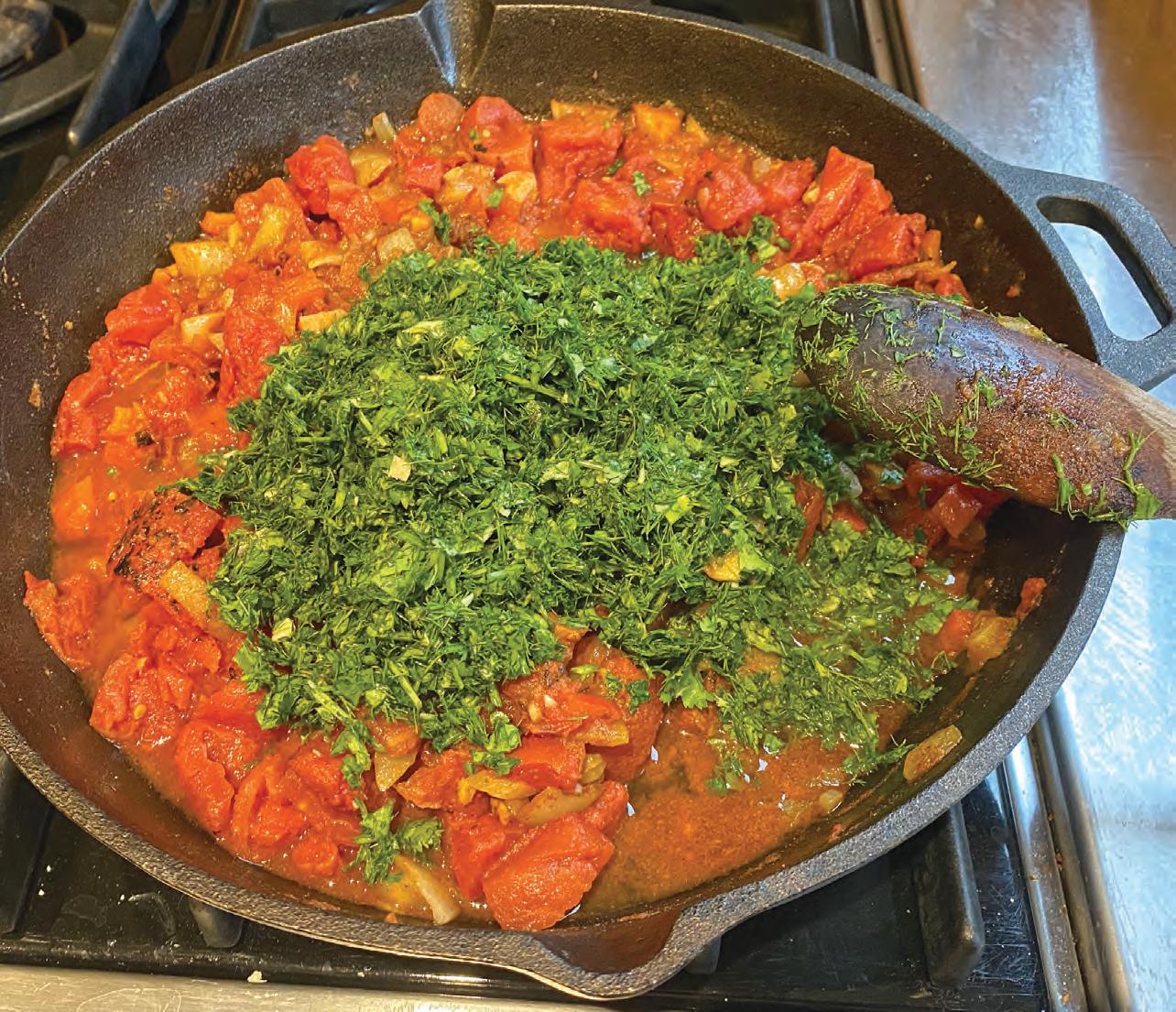
off season 2022 31
Preparing the Shakshuka on the stove top.
Minestrone for a Rainy Night
SERVES 4- 6
With enough for lunch the following day.
Note: No need to pre-chop anything, as this is worked into the timing.
3-4 Tbsp. olive oil
1 large sweet onion, diced
5 leeks, thinly sliced and chopped
5 stalks celery, small dice
3-4 carrots, small dice
2 bay leaves
2 bunches of Italian parsley, chopped
1 large Parmesan rind
3-4 largish Yukon potatoes, small dice
1 can diced tomatoes
(I like Muir Glen)
1 can chickpeas (I like Westbrae)
1 tsp. Better than Bouillon Vegetable Base in two cups boiling water 1-2 bunches lacinato kale, chopped into ribbons 1-2 zucchini, depending upon size, cut into small cubes Parmesan loaf of crusty French bread
As the olive oil heats in a heavy pan, chop onions and throw them in the pan. While the onions soften, chop the leeks, and then throw them in. Cook onions and leeks for 10 min utes. While that is cooking, chop celery and carrots. Add them. Stir. Add the bay leaves.
Chop parsley and potatoes. When the celery and leeks become fragrant, add the parsley, potatoes, and Parmesan rind. Stir around. Cook for a minute or two.
Add the tomatoes. Cook for a minute or two. Add the chickpeas. Add the 2 cups of vegetable broth, along with 2-3 more cups of boiling water. Stir around. Chop kale and zucchini. Add this to the mix ture. Cook until the potatoes are done. Serve with Parmesan.
Alternate: Ladle soup into ovenproof bowls, place slices of French bread on the soup, and put a handful of Parmesan on top. Place on a cookie sheet and broil for a minute or two until the cheese melts and turns golden.
Additional thought: My friend Gail Arnold and I were chatting, and she too follows this basic outline for minestrone, but she uses a mushroom dashi powder for her broth, which adds another layer of umami to the recipe.

32 edible VINEYARD FEATURE Keep it simple
A warm winter table, with minestrone soup and grated cheese.
SERVES 4
A few glugs good olive oil
A large sweet onion, finely chopped A zucchini — if it is in season, or you are craving some green crunch — chopped into ¼-inch dice
Corn from a cob, or about 1 cup frozen corn (or no corn, if you don’t like corn)
heaping Tbsp. chili powder two heaping tsp. cumin a tsp. or so of maple syrup
Can of green chilis, or about ¼ cup of some green Hatch chilis
A shake of Bragg Aminos — maybe a tsp.? two 15-oz. cans organic black beans (I like Westbrae), or three cups cooked black beans, rinsed
Large heaping handful of cilantro (unless it tastes like soap to you), chopped
Sauté the onions in a few glugs of olive oil for a few minutes. Add the zucchini and corn. Cook for about three minutes. Add the cumin, chili powder, and green chilis, Bragg Aminos, and maple syrup. Cook for a minute or two. Add the beans. Cook until the beans are warm. Add cilantro. You are done.
What to do now? Serve with steamed rice, some grated sharp Cheddar cheese, and guacamole.
Make burritos!
Heat oven to 350°. Make rice. While rice is cooking, sauté some kale (or spinach, or chard!) in a bit of olive oil, butter, garlic, and chili flakes. Grate some sharp Cheddar cheese.
Take a large flour or corn tortilla, place it on some aluminum foil (large enough to wrap the tortilla up into a burrito), place the cheese on the tortilla, add some rice, beans, and greens on top.
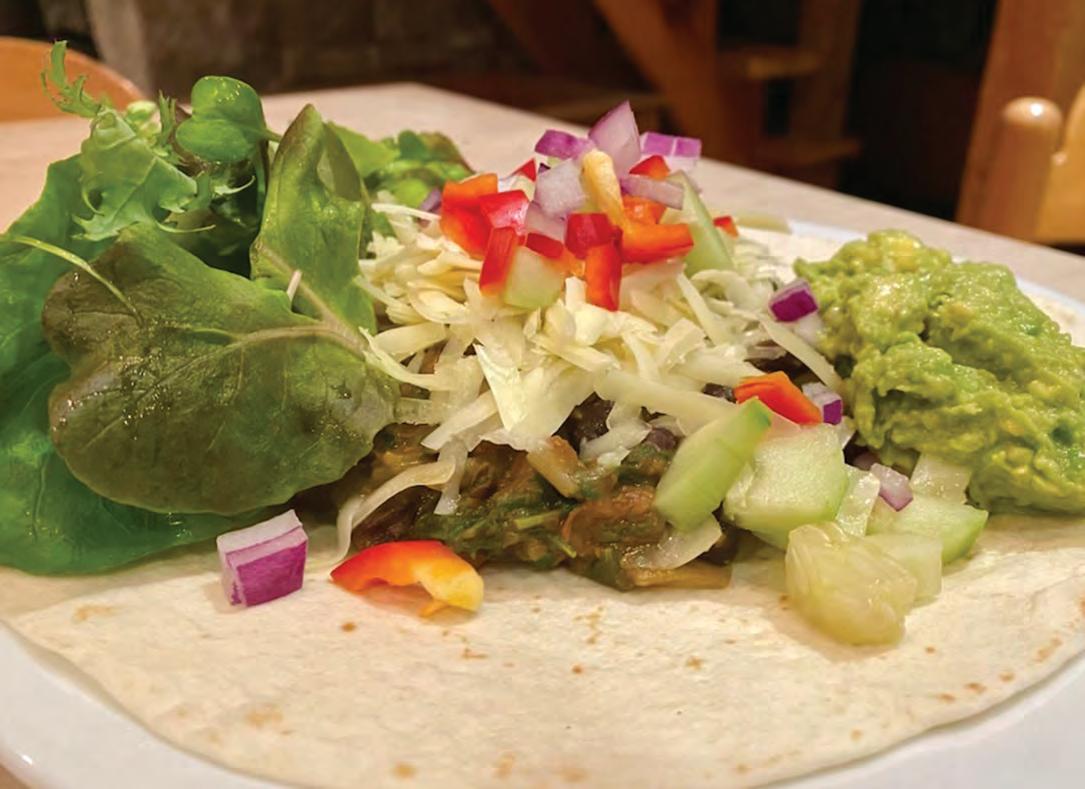
Roll the tortilla up in the foil, and place in the oven for about 12 minutes. Serve with guacamole and sour cream.
Make
tacos!
Chop up some crunchy romaine, red onions, red peppers, cucumbers, and whatever else you and your family like on tacos. Grate some sharp Cheddar or Monterey Jack cheese. Place all fixin’s in pretty bowls at the center of the table. Maybe include some salsa, guacamole, and sour cream? Hot sauce too!
Heat up taco shells. Put the beans in the taco shells, and let folks jazz them up.
Make quesadillas!
Place a large tortilla in a wrought-iron pan. Put some grated Cheddar or Monte rey Jack cheese on the tortilla. Add the beans. Put another tortilla on top. Cook until the cheese begins to melt. Flip, and serve. Best served post-surf or -sledding!
Burritos stuffed with fresh veggies and black beans.
Everyday Easy Black Beans
off season 2022 33 Keep it simple FEATURE
Get fresh updates on our work to ensure the future of agriculture includes all Americans.
farmland.org
Discrimination against marginalized groups in agriculture negatively affects all Americans by limiting the opportunities for farmers, workers, and consumers.
AFT is raising up diverse voices in agriculture, because we believe diversity contributes to a more resilient agricultural system, a stronger economy, and a more equitable society.

At American Farmland Trust, we believe agriculture is strengthened through diversity, just like the soil.
Dinner at the DAVIS HOUSE
Breaking bread at a home with a very, very long and storied history.
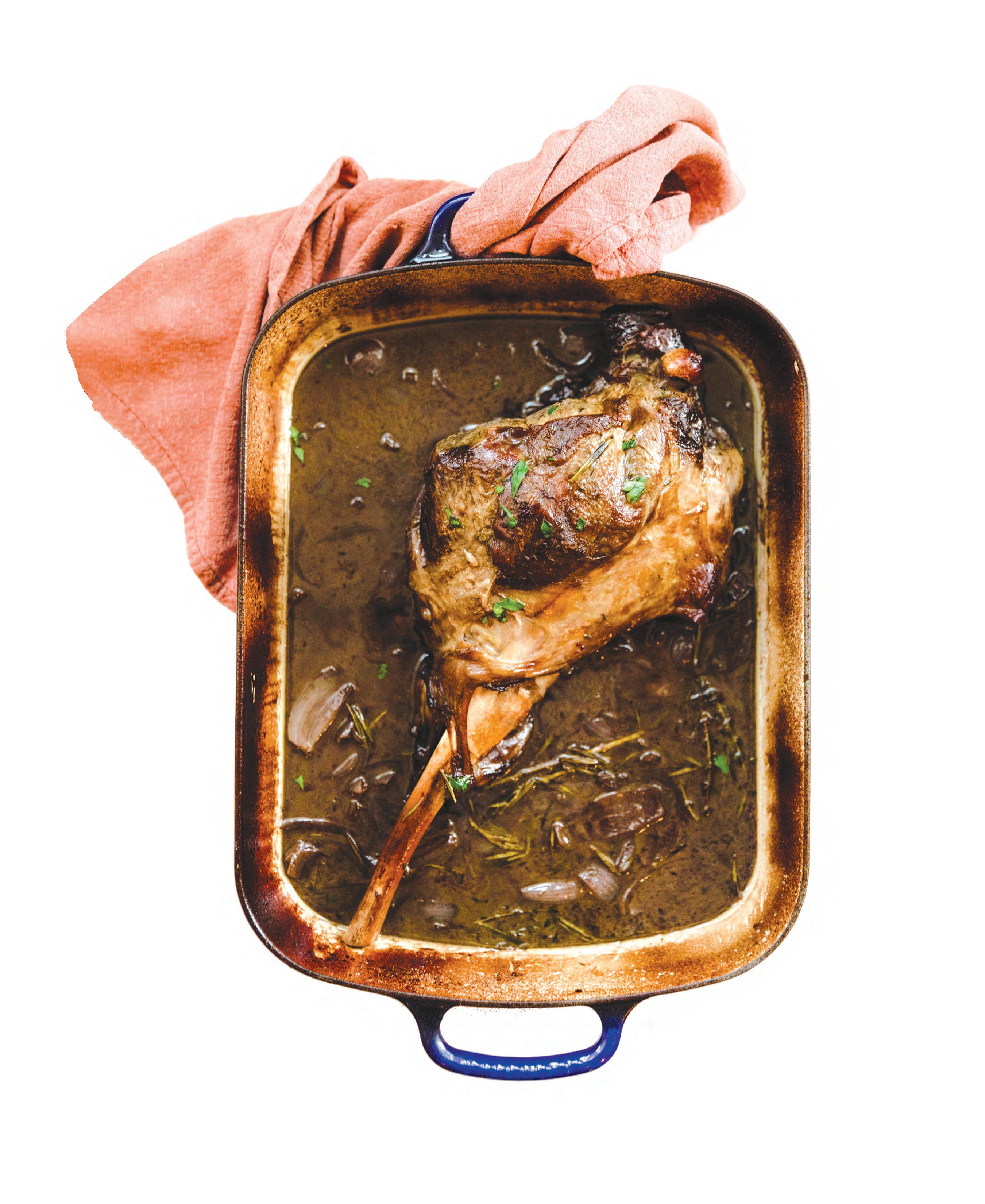 WORDS Tina Miller IMAGES Elizabeth Cecil
Dinner at the Davis House ON THE FARM
WORDS Tina Miller IMAGES Elizabeth Cecil
Dinner at the Davis House ON THE FARM
Allen Whiting still lives in the Davis House where he and his sister, Prudy Whiting, and brother, Danny Whiting, were born. Allen and his wife Lynne live in the iconic West Tis bury landmark, which doubles as a gallery for Allen’s paint ings in the summer. I joined Allen and Lynne in the kitchen of the Davis House as they were getting organized for the arrival of their nephew, Davis Solon, Prudy’s son, and his wife Gina for an off-season dinner.
The Whiting family are one of the oldest Island fami lies, coming to Martha’s Vineyard in the 1600s. Their family history is vast on the Island, but we are going to start at Whiting’s Farm in West Tisbury, a few centuries after their arrival on-Island.
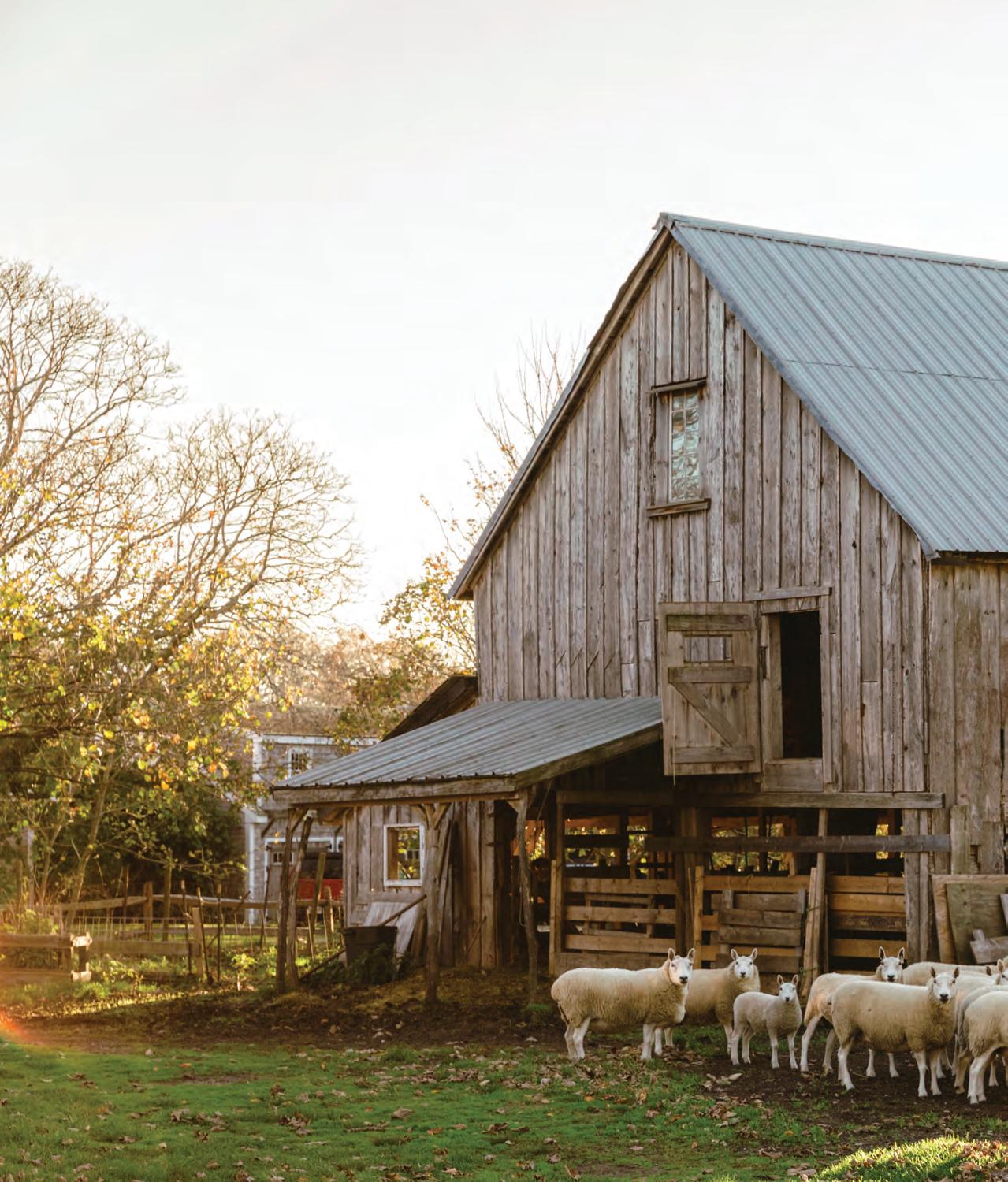
This forever-picturesque farm has been in the family since the mid-1800s when Henry Laurens Whiting retired from an es teemed cartographer career with the U.S. Geodetic Survey. Hen ry and his wife Anna Francis had three children: Johnson, Geor giana, and Virginia Whiting. Virginia left the Island, and Johnson stayed on the farm and married Emma Mayhew and had four sons — John, Everett, and two others that did not survive. Johnson and Emma raised John and Everett in the farmhouse, also known as “The Old Parsonage.”
“Johnson was a talented horseman and the farm was pretty fancy at that time,” Allen says. “He hosted horse races on a mile-long track he created out in the field.”
Georgiana met a young man named Everett Allen Davis from Rhode Island, who was on Martha’s Vineyard to attend Dukes County Academy, a school located in a part of the building that now houses Al len Whiting’s art studio. Everett Allen Davis left the Island to continue his education and later returned and married Georgiana.
Henry Whiting gifted Georgiana and Everett Allen Davis land where Everett Allen Davis built the West Tisbury landmark known today as the Davis House. Everett Allen eventually became a judge at the Dukes County Courthouse. Sadly, the couple could not bear chil dren but were like godparents to nephews Everett and John Whiting.
John Whiting, the eldest son of Henry and Anna, set off for college at Yale, eventually earning a doctorate in sociology and anthropology.
36 edible VINEYARD
ON THE FARM Dinner at the Davis House
He became a faculty member at Yale and eventually at Harvard. The Island, always his home, became a summer retreat as he set up camp on the Chilmark side of the Tisbury Great Pond.
Years later, younger brother Everett followed John to Yale, completing almost a year at university, then returning to his home and farm.
“My father was very intelligent, I was always proud of that,” Allen says. “He was the guy to go to if you needed help.”
Georgiana and Everett Allen left the Davis House to Ever ett Whiting when they died, and he and his wife Jane Mayhew Whiting’s three children — Danny, Allen, and Prudy — were born there. Years later the family moved into the Old Parsonage to live
for quite some time. In 1970, Jane Whiting died and Everett even tually remarried and lived with his wife, Nancy Hodgson Whiting, in the Old Parsonage until he died suddenly in 1981 at 66 years old. His death was a shock to the family.
“The farm was a great place to grow up for Prudy, Danny, and me,” Allen mused. “Our father never told us we had to stay and keep the farm and continue the tradition, but somehow we knew we did and we wanted to.”
Allen did go away to boarding school when he was high-school age and to Miami for college, transferring and graduating from Windham College in Vermont. Eventually, the farm and his fam ily called him back.

“Our father never told us we had to stay and keep the farm and continue the tradition, but somehow we knew we did and we wanted to.” –Allen Whiting
The Whiting Farm sheep huddle by the barn.
off season 2022 37
Dinner at the Davis House ON THE FARM
ON THE FARM Dinner at the Davis House
Allen and Lynne met back in 1976 when Lynne, who is from Salt lake City, was working at the Field Gallery in West Tisbury.
“When I came in after Allen’s show was hung, I was amazed at these beautiful soothing green landscapes. I thought the artist must be old and comfortable with himself. I thought Allen’s father Everett must be the artist.”
When she did see Allen, who at the time had a 3-year-old son, Wil lie Whiting, from a previous marriage, she was surprised the artist was so young.
At the time Allen and Lynne met, brothers Allen and Danny — who were both single at the time — referred to their living situation in the Davis House as “On the Rocks.”

The Davis House has had many lives, with someone occupying it ever since it was built. At one point it was an art gallery where art ist Kib Bramhall exhibited his work. Allen found this inspiring, and it gave him the idea that he could be an artist too.
Early in their relationship, Allen and Lynne lived in what is known as “the chicken coop,” located next door to the Davis House. The Hot Tin Roof live music venue rented the main house for performers such as Bonnie Raitt, Peter Tosh, James Montgomery, Delbert McClinton,
and others back in the day. The Davis House was a social hub over the years, but the house has always been a family gathering spot as well.
Lynne and Allen were married by the late John Alley in 1978 in the Davis House. “John didn’t wear his top hat!“ Lynne laughed.
“I’ve never been lonely in this house; we have always felt taken care of in this house,” Lynne adds. “Whatever we needed, showed up.”
Allen and Lynne raised their own two children, Beatrice and Everett, at the farmhouse. Everett and Davis Solon, Prudy’s son and Allen and Lynne’s nephew, grew up thick as thieves like brothers on the farm, and it continued to be an idyllic place to grow up for generations.
Today, Allen and Lynne enjoy the house filled with grandchil dren Asa, Nora, and Prudence, and of course, more family and great gatherings. Before becoming grandparents, Allen and Lynne got to practice grandparenting as great-aunt and uncle to Davis and Gina’s daughter, Isla Jane.
“The farm is in the best shape in forty years,” Allen says. Though this is a not-for-profit farm, they have no debt on the property and the land is locked up in conservation, which Allen, Danny, and Prudy did after their father Everett died with no will or plan in place. The farm
Allen and Lynne Whiting, Gina and Davis Solon, and Tess the dog in front of the Davis House.
“I’ve never been lonely in this house; we have always felt taken care of in this house. Whatever we needed, showed up.” –Lynne Whiting
will always stay a farm and never be developed.
Allen, an esteemed painter as well as a farmer, spoke about the responsibility of keeping the fields open for the enjoyment of those driving by to soak in the timeless landscape and the open fields where the sheep graze. The colors change daily on the property, according to the light of the season. He feels that is as important as raising sheep to maintain the farm.
These days, Allen, Prudy, and Danny keep it simple, raising only Cheviot sheep, a white-faced breed still thriving in the United Kingdom. Allen says they are not a pure breed, but close enough. Also roaming the farm are some chickens handy for fresh eggs. The newest addition to the family is Allen and Lynne’s ridiculously cute puppy, Tess. Prudy Whiting lives next door in an old con verted barn on the over 56-acre farm that lies in the center of old West Tisbury. Gina and Davis Solon, and Willie, Everett, and Bea Whiting all have property on the back side of the original farm.
The low winter sun is dancing through the window as Gina and Davis arrive for a small family dinner.
“Gina is kind of an old spirit, and she is one of the best addi tions to the family,” Lynne gushes.
The two bond over gatherings, food, holidays, and family. They
are planners and like to “get stuff done.”
Gina brings a roasted leg of lamb from the farm, and Allen lights up as she walks through the kitchen door engulfed in deli cious aromas from the roasting pan.
Lynne has harvested late-season oversized colorful chard from her garden out back and rinses and slices it. She adds olive oil and five cloves of chopped garlic to her saute pan and cooks it up, finishing the chard with a light splash of red wine vinegar.

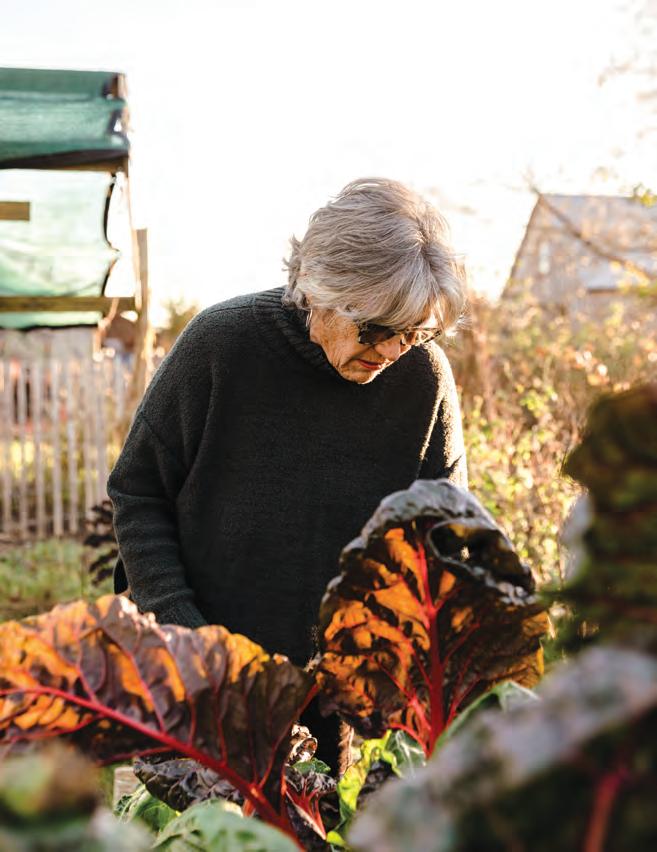
Along with the leg of lamb, Gina also brings smashed roasted red potatoes doused in olive oil that also smell and look incredible.
Allen loves lamb, especially his own lamb, but It is something Lynne has never cared for.
“I gave a lamb chop to Lynne once, that was the only time,” Allen laughs. “Years ago we used to attend potlucks, and though I always heard that everyone didn’t eat meat, we would show up with a roasted leg of lamb from the farm, and I can say all that was left was the shiny bone.”
Lynne happily goes with the flow and eats the delicious vegeta bles she and Gina prepared, and she’s happy to catch up with Gina and Davis in this old, very special house on the farm. If these walls could talk.
Dinner at the Davis House ON THE FARM
off season 2022 39
Lynne’s colorful chard.
Lynne harvesting late-season chard from her garden.
Roasted Smashed Baby Potatoes
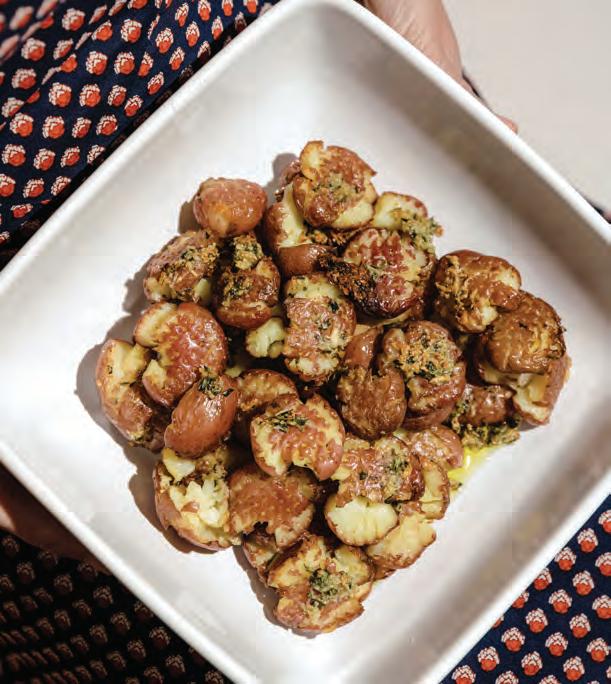
1 pound small red potatoes, scrubbed clean 3-4 cloves garlic, grated on a microplane ¼ cup olive oil, plus more for drizzling Kosher salt
Fresh ground pepper
2 heaping Tbsp. fresh thyme, chopped
Preheat oven to 400°
Fill a large pot with water and add a generous sprinkle of salt. Add potatoes and bring to a boil. Once boiling, turn heat to low and simmer for approximately 9 to 12 minutes — this will depend on the size of your potatoes. Once a fork can easily pierce all the way through they are done.
While the potatoes are cooking, in a small bowl add olive oil, garlic, thyme, and a few pinches of salt. Mix with a spoon and set aside.
Remove the potatoes from heat and drain.
Coat a large baking sheet with a few glugs of olive oil, add the potatoes and roll them around to coat. Carefully, when cool enough, press each one down until they are about an inch or so thick. I use the bottom of a glass jar or a meat tenderizer to do this.
Spoon garlic mixture onto potatoes, top with a few grinds of pepper and place them in the oven.
Bake for about 15 to 20 minutes, finishing with 2 to 4 min utes on broil, until very golden.
Roasted Whiting Farm Leg of Lamb

1 four-pound leg of lamb
2 medium yellow onions, sliced lengthwise
5 or 6 shallots, sliced lengthwise
1 small bunch of thyme
3-4 sprigs of rosemary
1-2 sprigs of marjoram
¼ cup olive oil
2 cups red wine (pinot noir is a nice choice)
4-5 cups beef stock
Salt and pepper
3-4 Tbsp. chopped parsley
3 Tbsp. safflower oil (or any high-heat oil you have on hand)
Preheat the oven to 425°
Rinse the lamb and pat dry. Coat generously with salt and pepper. Heat a large cast-iron dutch oven over medium-high heat. Add the safflower oil and carefully place the lamb into the pan. Sear until very brown and shimmery. Flip and repeat.
Turn off heat. Add the olive oil, onions, shallots, herbs, wine, and stock.
Top with lid and place in the oven. After about 20 minutes or so, reduce the temperature to 325° and cook for about 3 hours more, checking occasionally to see if you need to add any more liquid.
Remove from the oven and let rest for about 20 minutes, and re move herb sticks. Slice and arrange on a platter with onions and jus. Top with chopped parsley.
40 edible VINEYARD
Gina’s smashed red potatoes.
ON THE FARM Dinner at the Davis House
Roasted leg of lamb, fresh from the farm.

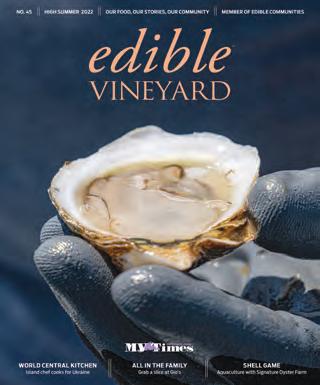
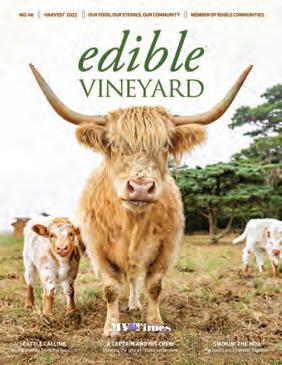
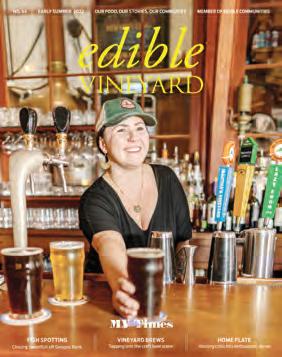
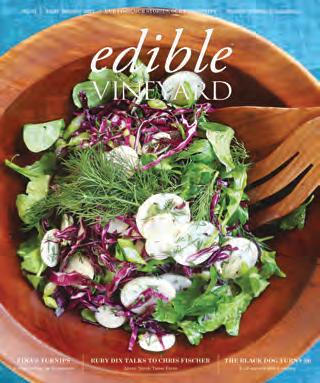

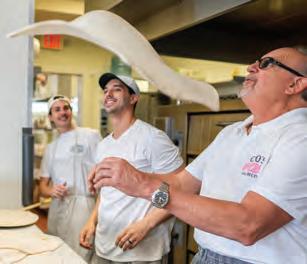
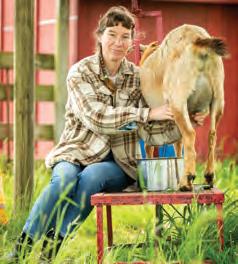
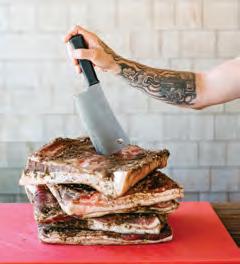
Save your appetite for 2023, advertise in all 4 issues of Edible Vineyard magazine. May · July · October · December Mention this ad when you book all four for the year and get a FREE web ad on ediblevineyard.com. To advertise, email adsales@mvtimes.com or call 508-693-6100 press # 35
All summer long, we Islanders romanticize the off-season, when we can finally hear ourselves think and tackle those projects we didn’t have time for during the summer time hustle. Tourists scatter, and the locals are free to enjoy walks on empty beach es, or stop on a back road to chat with a friend without getting honked at. It’s love ly. At first. But toward mid-January, when the cheerful holiday lights come down and the novelty of New Year’s resolutions fade, things can get a little too quiet.
Luckily for us, that is precisely when Mother Nature starts sending blizzards our way.
Unlike schoolchildren, the farmers we know do not get excited about bad weather. Storms are stressful, hard on the animals and equipment, and so much work. But my husband and I are the gleeful exception. A blizzard warning is the unexpected gift that shakes up our winter routine. Like a holiday, there are different rules for drinking and eating and daily activities. It’s not like we were planning on doing anything anyway, but when the Island shuts down for a day or two, all the cozy hibernating we’ve been doing for months suddenly seems exciting.
went out. Scrambling for flashlights in the darkness, and grabbing mismatched winter accessories on the way, we ven tured out into the storm.
A branch had fallen off a nearby locust tree, not exactly on the rabbit hutch, but grazed it enough to rip the plastic sheeting that was blocking the icy northeast wind. The idea of attempting the repair in said wind did not appeal to us, so we quickly made the decision to tuck the bunnies under our parkas, and make them a tem porary home in a newspaper-lined dog crate by the fire.
We doze some more until daybreak, but it’s still so dark and windy out that we take the morning slowly. Experience
DARK AND STORMY NIGHTS
We stop for a few ne cessities at the grocery store and make sure we have enough gas for tractors and chainsaws, but Islanders in general, and particularly Island farmers, don’t panic in the face of any storm. Our pantries are always stocked with nonperishables and freezers with farm-fresh meat. We have backup generators, and a wood stove and good old-fashioned Yankee determination and resilience, on our side.
We do, however, enjoy the change of pace. We’re cheerful little worker ants, spreading extra shavings before closing our critters safely in their shelters. Then we head up to the house to start a pot of stew and mix our favorite blizzard-inspired cocktail. We light candles, even though we still have electricity. We revel in the antici pation, knowing we’ve prepared as much as we could, and hoping it’s enough.
On one such dark and stormy night, my husband Brian and I were woken by a crash just after midnight. We were still on the couch, having fallen asleep watching a movie just before the power
IMAGE

has told us that the animals are all still hunkered down in their cozy shelters — instinct urging them to stay put and rest until the storm subsides. We light the pi lots on the stove with a candle, so we can make pancakes and bacon and stovetop espresso in the absence of electricity. We linger over a game of Scrabble until the cozy glow of storm togetherness gradu ally starts to fade. The kids are bickering over the last piece of bacon, and the song Brian has been humming all morning is now stuck in my head too, and there’s no radio to put on and drown it all out.
Recognizing the beginnings of cabin fever, and to save everyone’s sanity, we bundle up and head outside. My husband and I ride together on the ATV, and I wrap my arms tight around his waist in apology for the morning’s grumpiness. The kids jump through snowdrifts behind us. The chicken coop is standing proudly, though the weight of the snow is causing the roof of their run to sag in a way that suggests yet another winter project to add to the list. The latch on the door is frozen, and it takes my husband a few minutes of brute force to open it, while the kids and I shovel the snow away from the door. The hens immediately rush to the entrance, curious about the fresh, frosty air, but then stop short at the threshold, suddenly skeptical of the peculiar landscape. One brave bird touches the snow gingerly with her foot and pulls it back, letting out a cluck of alarm that is echoed by her coopmates. We shake our heads at what chickens our chickens are being, toss some food on the ground for them, and move on to check the rest of the farm.
The sheep are also huddled cautiously in the door of their barn, but are quicker to run out when we dole out hay and grain. Our muscovy drake, RunAmok Duck, hasn’t fared as well. He tried hunkering down in the grain shelter, apparently not quite as out of the wind as he thought he was, and a huge hunk of ice has formed on his chest feathers. He hitches a ride with us back to the house, and we dispatch our sons to find a cardboard box, some towels, and a hairdryer.
The power is on when we return to the house, so the kids and I set about thawing the duck and filling the rabbits’ water bottles. Brian is out plowing, and I catch a glimpse of him through the kitchen window, expertly maneuvering the Kubota tractor around the hills and stone walls buried in the snow. So self-assured, so capable, such a handsome smile under that goofy winter hat. How is this the same man I accused of cheating at Scrabble just hours ago? It strikes me that marriage is a lot like an Island winter — long stretches of tedium punctuated by unexpected squalls of catastrophe. Fortunately, the same qualities can get you through both the boredom and the stress: flexibility, patience, humor … and most important of all, irresistibly alluring tractor moves.
42 edible VINEYARD ON THE FARM Dark and stormy
nights
The off-season gets even more quiet in a storm.
ESSAY Kate Athearn
Karen Blackerby Logan
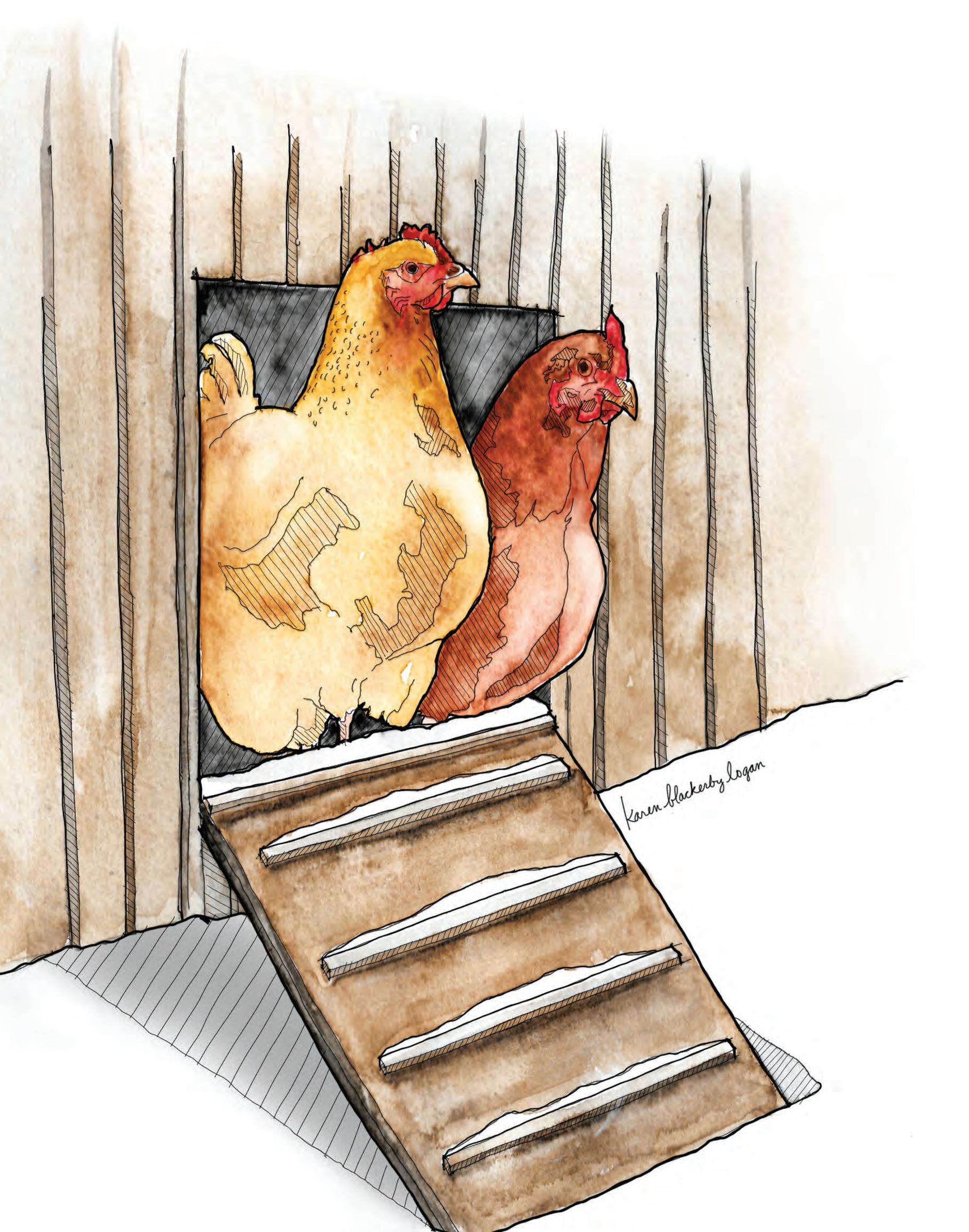
off season 2022 43
Dark and stormy nights ON THE FARM
We light candles, even though we still have electricity. We revel in the anticipation, knowing we’ve prepared as much as we could, and hoping it’s enough.
COME AND GET IT!
Succotash chowder brings everyone to the table on a chilly night.
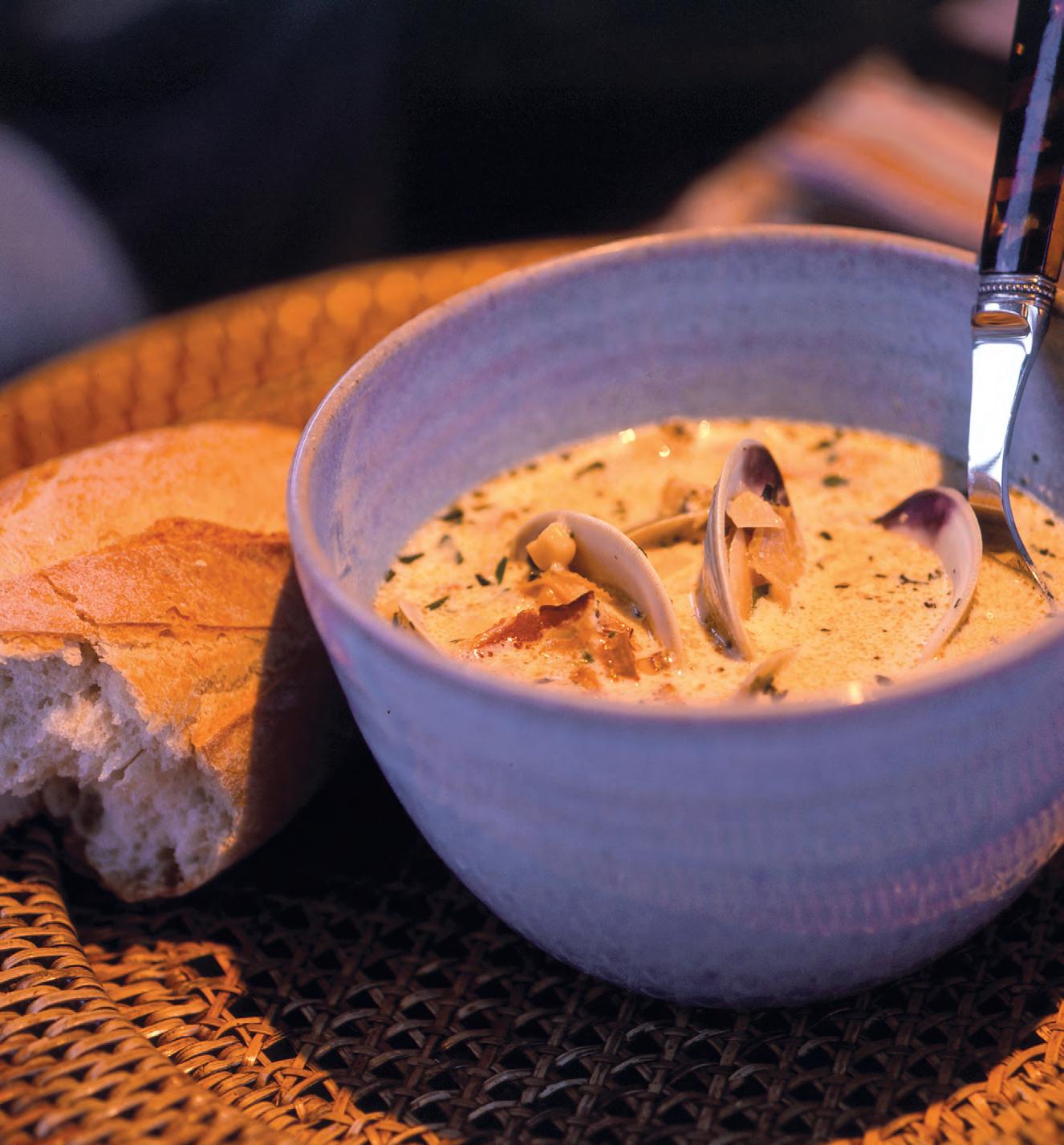
44 edible VINEYARD
IN SEASON Succotash Chowder with Little Neck Clams
WORDS Tina Miller IMAGE Alison Shaw
To me, chowder is best in the chilly weather. There is some thing less appealing about hot creamy soup in the heat of summer. This succotash chowder was created years ago for my cookbook “Vineyard Harvest,” which came out in 2005. This light, brothy, flourless chowder is fresh and delicate. Also, it is great for winter when your pantry is your friend and using frozen vegetables is a fine thing to do. There seems to be a lot of steps, yes, but it is still quite simple and the method is easy.
Like any good soup, stew, or chowder, I feel this chowder tastes best after curing overnight, letting the flavors come together. There is no flour for thickener, which also stabilizes the cream, so be careful heating the cream so it does not curdle. This means after curing, the chowder is best cooked and served, and not left on heavy heat for a long period of time.
Succotash Chowder with Littleneck Clams
Serves 6
5 strips bacon, cut into ½ -inch pieces
1 medium yellow onion, diced 1 medium shallot, minced
2 Tbsp. fresh thyme, chopped 3 Tbsp. fresh parsley, chopped 2 cups clam broth
3 cups heavy cream
½ cup dry white wine
7 lbs. littleneck clams, scrubbed 1 Tbsp. olive oil
½ cup corn, (frozen is fine)
½ cup red pepper, diced small ½ cup lima beans, blanched (frozen is fine) ½ tsp. black pepper
In a heavy 6-quart saucepan, cook bacon over medium-high heat until crispy. Remove the bacon, leaving the fat in the pan. Set bacon aside. Lower the heat, and add onions and shallots, sautee gently care ful not to brown. Stir in chopped thyme and parsley, combine, add clam stock, turn up the heat, and gently boil for a few minutes.
Reduce the heat and add the cream, simmer for about 10 minutes. Remove from heat.
In another heavy saucepan, add white wine, add littleneck clams, setting 24 clams aside. Cover and steam until the clams just open. Re move clams from the pot, removing any that do not open at all. Let clams cool enough to handle. Remove cooked clams from the shell. Coarsely chop cooked clams.
Heat olive oil in a saute pan. Add corn, peppers, and lima beans. Cook over medium heat for a few minutes. Remove from heat.
To assemble the chowder, add chopped clams, succotash mixture, and crispy bacon to the cream base. Chowder is always best the next day, so I suggest refrigerating overnight.
When ready to serve, heat the chowder mixture gently, add 24 un opened live clams, and heat until the littlenecks have opened.

off season 2022 45
Little Neck Clams IN SEASON
Succotash Chowder with
to medium-high. When the water reaches a rolling boil, take the pan off the stove, cover it, and set aside for 8 minutes. Drain the eggs, shock them in ice water, and peel them.

To make the shortcake biscuits, com bine the flour, sugar, baking powder, and salt in a food processor. Pulse to mix. Add the yolks, pulse to combine, then add the butter and process until the mixture is the texture of coarse meal (when it’s right, the butter will no longer sound rumbly and the largest pieces will be no bigger than a lentil), about 15 seconds.
Transfer the dough to a bowl. Add 1 cup and 1 tablespoon cream and stir with a fork just until the flour is moistened and the dough is clumpy and shaggy (if the dough seems very dry, add up to another table spoon of cream). Turn the dough onto a lightly floured work surface. Gather the dough together with your hands and form it into a compact square, and, using a roll ing pin, roll the dough into a 6-inch square.
Trim the ragged edges and cut out 8 shortcakes with a sharp knife or cutter (squares are most efficient). Roll the trimmed scraps into an additional shortcake.
Line a baking sheet with parchment pa per. Arrange the shortcake biscuits on the prepared baking sheet and allow them to rest in the refrigerator for at least 30 minutes.
Preheat the oven to 375°F. Brush each biscuit with cream, sprinkle with crystal lized sugar, and bake for 10 minutes. Rotate the pan front to back and continue baking until the biscuits are golden, about 10 min utes more. Set the biscuits aside to cool.
To make the blackberry reduction, combine 340 grams (12 ounces) blackber ries, 70 grams (2.5 ounces) sugar, and the zest in a small saucepan. Crush the berries with the back of a wooden spoon. Bring the mixture to a boil over medium-high heat, then lower the heat and simmer until the berries are soft and have released their juices, about 10 minutes. Press the berry compote through a fine sieve. Reserve the reduced syrup and discard the berry pulp.
Shortly before serving, make the yo gurt cream. Combine 1 cup cream, the va nilla, and confectioners’ sugar in a stand mixer or bowl. Whip until the cream holds soft peaks. Add the yogurt and whisk to gether until blended.
To assemble the shortcakes, slice each biscuit in half horizontally with a serrat ed knife. Arrange the bottom halves on serving plates. Put 420 grams (15 ounces)
fresh berries in a large bowl and dress them with the berry reduction, stirring gently to coat the berries evenly. Dollop whipped yogurt cream on the bottom bis cuit halves, spoon blackberries over the cream, then finish the cakes by topping them with the other biscuit halves. Dust with confectioners’ sugar and serve.
GOUDA PIZZELLES
Stroopwafels are Dutch caramel-filled crisps first made in the town of Gouda. They have always reminded me of Italian pizzelles. The last time I had my pizzelle iron out, I wondered if I could trade sug ar for cheese and make a cocktail snack. I tried Gouda (in a nod to waffle cook histo ry). It was delicious and so is cheddar. As I mentioned in my recipe for sweet Pizzelles (page 109), I have an electric pizzelle maker, so I haven’t tried any of the ingenious hacks I have read about on the internet — but if I didn’t have an iron, I might.
All-purpose flour (8.1oz/about 1 1/2 cups + 2 1/2 Tbsp.) 1 1/2 tsp. baking powder
Diamond Crystal kosher salt (1 tsp.) Dry mustard 1 1/4 tsp. 3 large eggs, lightly beaten Aged Gouda cheese (5.3oz/about 1 1/2 cups), grated Unsalted butter (4oz), melted and cooled Cooking spray
Heat a pizzelle iron. Sift the flour with the baking powder, salt, and mustard into a bowl. In another bowl, combine the eggs with the cheese, then whisk in the melted butter. Using a wooden spoon, mix the wet ingredients into the dry to form a stiff batter.
Spray the pizzelle iron with cooking spray (you only need to do this before the first pizzelle). Spray a dinner spoon with cooking spray and drop a spoonful of batter onto the heated iron (I find it easier to get the batter off a dinner spoon than a measuring spoon). Lower the top of the iron and cook the wafer until it is golden, about 45 seconds. Remove the pizzelle and repeat, blotting any accumulated oil from the iron with a paper towel as necessary. Cool the pizzelles, then serve. Stored in an airtight container, piz zelles will keep for up to a week.
46 edible VINEYARD
FEATURE Sweet and Savory
Continued
page 13
from
Claudia Fleming, author of the cookbook "Delectable."
GINGER-STOUT LAYER CAKE WITH ERMINE FROSTING

MAKES ONE 8-INCH 3-LAYER CAKE
I reworked my gingerbread recipe, pub lished in “The Last Course,” and wound up with a delicious cake. I don’t like too much frosting, so I’m happy with generously ic ing between the layers and then finishing the top, leav ing the sides au naturel. If you feel as I do, a single recipe of Buttermilk “Ermine” Frosting will do the trick; if you like more, increase the recipe by half.
CAKE:
1 cup stout, such as Guinness
1 cup molasses
1 Tbsp. freshly grated ginger
1 Tbsp. baking soda
Cooking spray or unsalted butter, for the pans
3 large eggs, room temperature
100g sugar (3.5oz/about 1/2 cup)
110g dark brown sugar (3.9oz/about 1/2 cup)
neutral oil, such as canola
3/4 cup all-purpose flour (4.9oz/about 1 cup), plus extra for the pans
1 1/2 tsp. baking powder
2 Tbsp. ground ginger
3/4 tsp. ground cinnamon
1/4 tsp. ground cloves
1/8 tsp. ground cardamom
1/2 tsp. Diamond Crystal kosher salt
FROSTING:
1 recipe Buttermilk “Ermine” Frosting
50g all-purpose flour (1.8oz./about 5 ¾ Tbsp.)
1 ¼ cups buttermilk
1 ¼ tsp vanilla paste or pure vanilla extract
¼ tsp Diamond Crystal kosher salt 10 oz unsalted butter, room temperature 8.8oz/about 1 ¼ cups sugar 2 ½ tsp. lemon zest
To start the cake, preheat the oven to 350°F. Combine the stout and molasses in a large, deep saucepan that has plenty of room for the mixture to bubble up. Bring to a boil over medium-high heat. Pull the pan off the heat and whisk in the fresh ginger and then the baking soda. Set aside to cool. Prepare three 8-inch cake pans by
CLAUDIA FLEMING
dry ingredients, a third at a time. Divide the batter evenly among the three pans.
Bake the cakes until they are springy, the edges begin to pull from the pan, and a cake tester inserted in the middle comes out clean, 25 to 30 minutes. Remove the cakes from the oven and allow them to cool in the pans on a wire rack.
To make the frosting: Put the flour in a small saucepan, gradually whisk in the buttermilk, and cook over medium heat, whisking constantly, until the buttermilk thickens to the consistency of pudding, 5 to 10 minutes. Stir in the vanilla and salt. Transfer the buttermilk base to a bowl, place plastic wrap directly on the surface (to prevent a skin from forming), and set aside to cool. Combine the butter with the sugar in the bowl of a stand mixer. Using the paddle attachment on medium speed, cream the butter with the sugar. Add the lemon zest, switch to the whisk at tachment, and whip in the buttermilk base a little at a time, scraping down the bowl from time to time. Use im mediately or store in an airtight con tainer in the refrigerator for up to 3 days. Bring to room temperature and re-whip before using.
greasing each pan, lining the bottoms with parchment paper, then greasing and lightly flouring the paper. In the bowl of a stand mixer, use the whisk attachment to whip the eggs with the white and brown sugars to medium-high speed until they are com bined. Drizzle in the oil, whisking to incor porate. In a separate bowl, whisk the flour with the baking powder, ground ginger, cinnamon, cloves, cardamom, and salt. Re move the bowl from the stand and stir the (cooled) stout mixture into the eggs and sugar. Stir the egg/stout mixture into the
To finish the cake, use a serrat ed knife to level the top of each cake. Place the first layer on a cake stand or cardboard round and spread the surface with frosting. Place a second layer of cake on top of the first and spread it with frosting; top with the remaining layer. Fill an offset spatula and mound frosting on top of the cake, then spread it in an even layer. Leave the sides bare. Slice and serve.
Recipes excerpted from “Delectable” by Claudia Fleming with Catherine Young. Copyright © 2022 by Claudia Fleming. Photographs copyright © 2022 by Johnny Miller. Excerpted by permission of Random House, an imprint and division of Penguin Random House LLC. All rights reserved. No part of this excerpt may be reproduced or reprinted without permission in writing from the publisher.
off season 2022 47 Sweet and Savory FEATURE
“
A batter requires blending ingredients; if everything, including the eggs, is the same temperature, you get better emulsification, and that leads to a tender, moist cake.” –
Ginger-Stout Layer Cake with Ermine Frosting
DONE!
Susan Whiting of Chilmark has spent her life as a birder and naturalist. She says she is retired, but the Susan we know never stops. Edible Vineyard asked her about the seasonal migration of birds, the com ings and goings of birds on Martha’s Vineyard.
Susan Whiting: Fall on the Vineyard sees a human migration to points off-Island. It is not a surprise that many birds that breed or spend time here in the summer head south for the winter. However, if

you were to try to figure out how many birds are left after the fall migration, it would be difficult. Why? Because although our warblers, sparrows, hawks, and shorebirds leave, there is another group of birds that comes from north of us to spend the winter on the Vineyard. Which birds are those? Sea and dabbling ducks, winter wrens, and different species of sparrows, to name a few. So your guess is as good as mine.
Image Kate Feiffer
48 edible VINEYARD
DONE!
An Island expert weighs in on avian comings and goings.
Take flight






Vineyard Haven 508-693-4457 • West Tisbury 508-693-2234 Vineyard Haven 508-693-7097




























































































































 WORDS Tina Miller IMAGES Elizabeth Cecil
Dinner at the Davis House ON THE FARM
WORDS Tina Miller IMAGES Elizabeth Cecil
Dinner at the Davis House ON THE FARM




























